Overcoming Learning Anxiety
Anyone can experience learning anxiety and solving it requires a system of your own creation that will make learning a joyful experience to you.
My goal with this post is to share my progression towards dealing with my own learning anxiety.
I realize the irony of writing a 7,000+ words blog post on the subject; it is probably not the best way to grab the attention of people who share that anxiety! I did my best to make this text as entertaining and light as possible, in the hope that, if you are also dealing with learning anxiety, you will be inspired to take steps towards overcoming this wall.
If you also experience learning anxiety, my hope is that this post will make you realize that you are not alone and that, with a little bit of creativity, you can get through any obstacle that stands in your way.
This post was initially featured on felixleger.com.
What even is learning anxiety?
I think this sums it up nicely:
There are two kinds of anxiety associated with learning: “learning anxiety” and “survival anxiety.” Learning anxiety comes from being afraid to try something new for fear that it will be too difficult, that we will look stupid in the attempt, or that we will have to part from old habits that have worked for us in the past. Learning something new can cast us as the deviant in the groups we belong to. It can threaten our self-esteem and, in extreme cases, even our identity.
You can’t talk people out of their learning anxieties; they’re the basis for resistance to change. And given the intensity of those fears, none of us would ever try something new unless we experienced the second form of anxiety, survival anxiety—the horrible realization that in order to make it, you’re going to have to change. Like prisoners of war, potential learners experience so much hopelessness through survival anxiety that eventually they become open to the possibility of learning. But even this dejection is not necessarily enough. Individuals can remain in a state of despair permanently.
How can leaders help their followers maximize their learning while minimizing their pain?
(Diane Coutu, The Anxiety of Learning)
Discovering I had learning anxiety
I wasn't always aware of how bad my learning anxiety was, and I'm convinced that most people who suffer that condition don't realize it either.
I knew I felt bad about my performance at work and had for a long time, but I couldn't quite put my finger on why. It's not that I wasn't trying hard enough: in fact, I felt I was trying so hard that I was getting close to burning out. However, I also felt like I wasn't accomplishing as much as I should have, considering the amount of energy I poured daily in my work. From the outside, it might have looked like this:
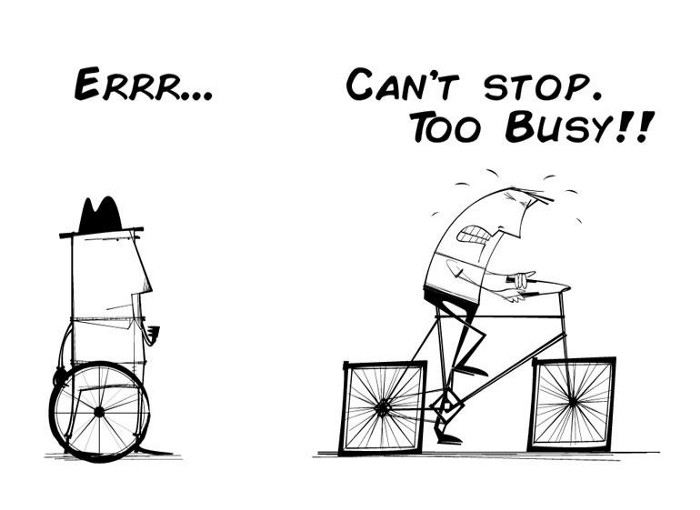
A series of events (which we'll get to, I promise) eventually put me in survival mode, where I had two possible outcomes:
- learn to adapt...
- ... or learn to let go.
This led me to read a certain DevOps handbook, which led me to write down these words:
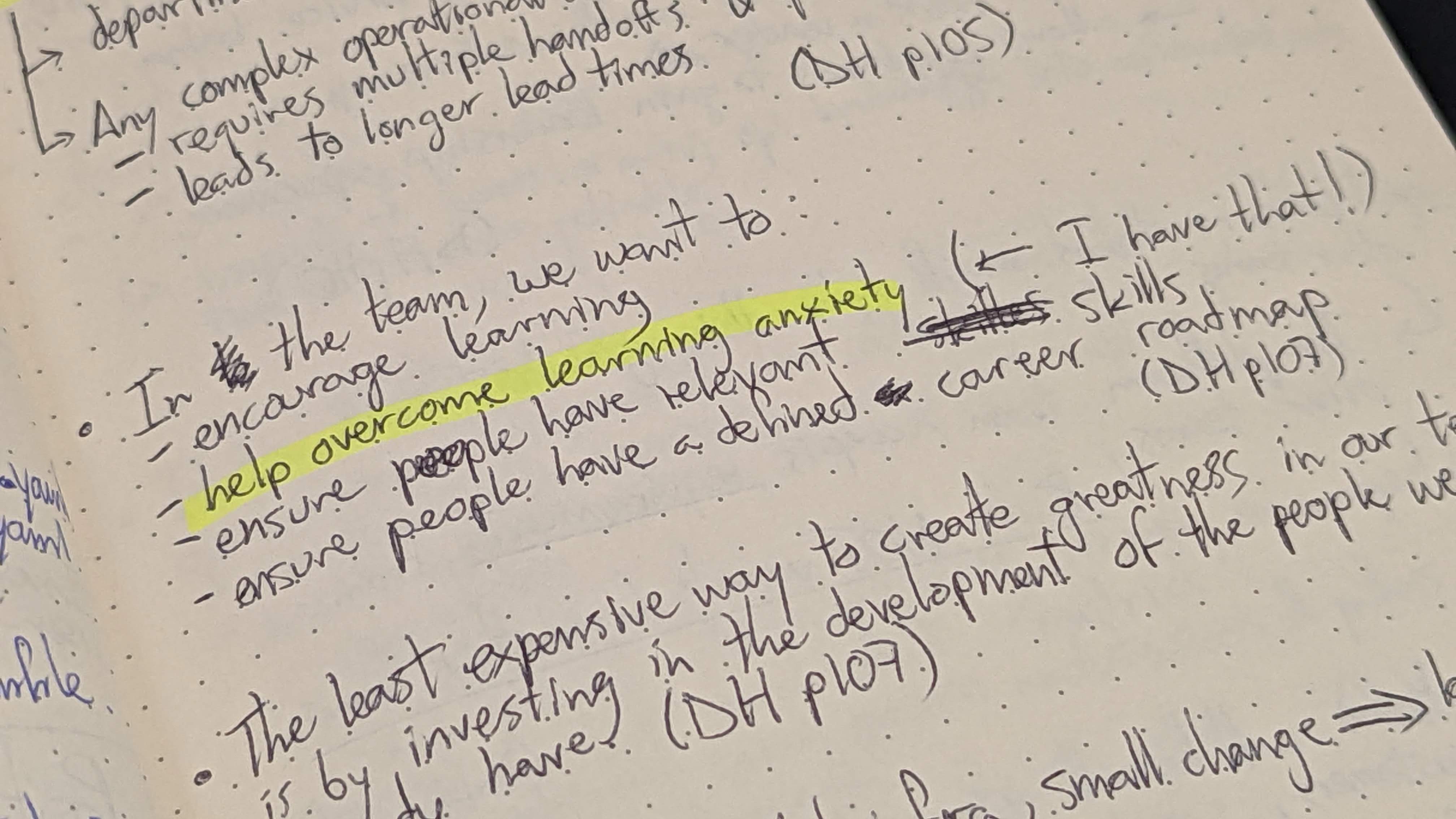
Well, here it is. This is the moment when my mind clicked and realized I had learning anxiety. Before writing it down and seeing it with my own eyes for the first time --- "learning anxiety" --- this is a concept that felt somewhat alien to me. Like, it made sense, but then how could I claim to have learning anxiety if I had a Masters in Physics? I felt like I had no excuse to feel the way I was feeling.
But it was true. I simply had plain old learning anxiety.
I certainly knew how I felt when it came to learning: to put it mildly, I felt my learning performance was below all those around me.
What I feel is ironic is that I had to overcome learning anxiety to realize this was precisely the problem holding me back from learning. In other words, as I was writing "help overcome learning anxiety (<- I have that!)", I hadn't realized that, precisely at that moment, I was beginning to heal.
Let's back up a bit to give you better context and hopefully walk you through the steps taken to untangle this mental knot.
Bad news and career changes
The catalyst that sent me on this whole journey was a piece of bad news I received from my new employer, nesto, in mid-June this year: I was getting a probation extension. I wasn't quite cutting it in the workplace. I had 2 months to course-correct, otherwise I could kiss my job goodbye. Part of the problem was the fact that I had trouble learning new concepts and remembering important details.
This is what put me into survival mode.
I had never been put in that kind of situation before, where a manager told me I was not pulling my own weight. I wasn't going to waste this opportunity to show the world what I could do when given proper motivation.
Let's rewind the tape even further and see how this mountain of anxiety all began.
The anxiety begins
In 2017, fresh out of University and ready to tackle the world, I started working for a newly-formed startup then called Proximity HCI (now known as Contxtful). I had just finished my Masters thesis in particle Physics and was ready to jump into the software world (this is something I already discussed on this blog in 2019).
I was hired as a machine learning scientist, and chipped away at tasks for many months, but clearly things weren't working out. With machine learning, I was simply "not on my X", as we say in French, meaning I wasn't in the right context to excel. As I naturally started working towards handling the IT of the company and discovering automated deployment pipelines, my then-manager (and trusted friend!) Alexandre Desilets-Benoit said something that would change my life.
"You know what? I think DevOps would be a good fit for you."
For someone with self-diagnosed impostor syndrome, receiving this kind of information is a mixed bag. On one hand, it finally provides an explanation to why you are having such a difficult time accomplishing the tasks you were given. This is a big plus. "Of course, it all makes sense now! I'm bad at machine learning because, deep down, I'm a DevOps! Change my title now, please! This will fix all my problems", I would say to myself. On the other hand, it places you in front of an undodgeable question: "What the heck is DevOps, anyway?"
You can then imagine why, depending on the day, my impostor syndrome simply got out of control. I was a Physicist who changed career paths after my Masters degree (because I felt I was bad at research) to become an ML scientist, only to realize I was even worse at that job, so much so that my boss recommended another career change, this time into a field I knew absolutely nothing about. I was rightfully terrified.
Not wanting to waste any time, I feverishly started Googling the most basic things, like "how to devops?" and "what is devops?". To give you an idea of the steepness of learning curve I was faced with, check out this great video from TechWorld with Nina and count how many times something along the lines of "you need to learn" or "you need to know" is said:
(I counted over 30 occurences.)
Every search result required me to do at least three other searches to understand what basic sentences meant. For a while, it felt like I was surrounded by buzzwords, with no one telling me anything. Oh how I wished Jimmy Neutron's "book gum" was real!
This process
lasted months years, and it was not pleasant. I felt useless. I felt ashamed. I wished I could go back in time and
learn about agile, CI/CD, and other DevOps requirements during my
studies instead of having filled my brain with equations of motion that I had
no use for. In short, at 27 years old, I already felt like I had missed the boat, and with each
passing day felt more like giving up.
The only thing pushing me forward was the fact that my colleagues depended on my work, as amateurish as it was. I could entertain the idea of going down in a big ball of fire, but I didn't want my colleagues to suffer the fall with me. I wanted them to thrive and excel at their rightfully chosen tasks. Ironically, I now believe this is precisely the kind of mindset that drives the DevOps philosophy: Do everything you can to maximize the value your peers can deliver. However, I was simply too discouraged at the time to realize this.
In 2019, as I was going on vacation, I stumbled upon a book called The Phoenix Project, which seemed really popular in the DevOps space as an entry point into the subject matter. Being written as a novel, I thought: "Ah! This is perfect material to read on the beach, without any pressure to learn. This is going to be great fun."
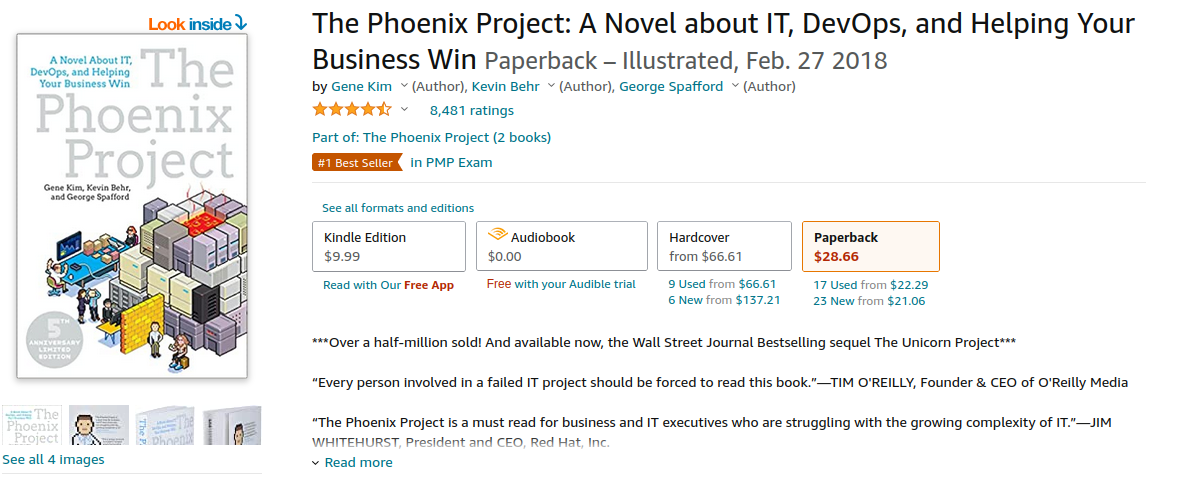
Buying the book is initially the easy part.
And it was! There are many reasons for this, I believe. Firstly, the book is, of course, very well written. It wouldn't sell over 500,000 copies if it wasn't. Secondly, and more importantly, the fact that I was open to the material and didn't feel pressured to understand everything right away made a key difference. Finally, and this is key, I enjoyed this book because I read it in its entirety, and this is something I will come back to in this post.
In 1 week, I had finished reading my first DevOps book. Woohoo! I felt like I was ready to conquer the world. My mind was now filled with ideas I was excited to try. The Phoenix Project subtly advertised for another book from the same author, The DevOps Handbook, which supposedly contained everything you needed to know to propel your business forward as Bill had done for Parts Unlimited in the Phoenix Project. I felt ready for it. Bring it on!
Conquering The DevOps Handbook
I ordered my copy of the handbook in 2019. I finished it on August 6, 2022. For those keeping count, that means three years of lead time. What happened?
Simply put, after a few chapters, I began to feel intimidated. This didn't feel like the Phoenix Project. It was a real book, one that required actual effort to read through.
Every new information felt like it took the spot of another one in my head, similar to a sort of musical chair of knowledge. For example, I had trouble remembering what the Three Ways of DevOps stood for, even though they were central parts of both the Phoenix Project and the handbook. It felt like I was drowning in information. If the Phoenix Project managed to organically sneak in a reasonable amount of information within the context of story, the DevOps Handbook proved to be too much for me. There seemed to be no time for relaxation: The handbook simply lined the knowledge nuggets one after the other relentlessly.
Very early on, I could feel my reading velocity diminish as I was reading my physical copy. I started reading the digital version on my Kobo to see if that could help, but I got the same result; Initial progress was quick, and then everything grinded to a halt.
Reluctantly, I shelved the handbook both physically and digitally, feeling ashamed and defeated.
This pattern of excitement for learning leading to bitter abandon was, as you might have guessed, not limited to the DevOps Handbook. Throughout most of my time at Contxtful, I was given the opportunity to learn, and by my own account, failed at it more than I succeeded. Eventually, the feeling of being unable to reach my full potential with Contxtful (and potentially hurting the company as a result) led me to join nesto, in the hope that there lied the key that would unlock this potential.
I just didn't expect that key to be the threat of getting the old boot!
Good fold, Bad fold
So I got to work, big time. My focus in mid-June was higher than ever, thanks to survival instincts that kicked into high gear. One of my first personal goals was to get through the DevOps Handbook before the end of my extended probation, partly to prove to myself that I could accomplish something for once.
And I am happy to report that I did (!!), thanks in no small part to a neat little trick that I am about to show you:
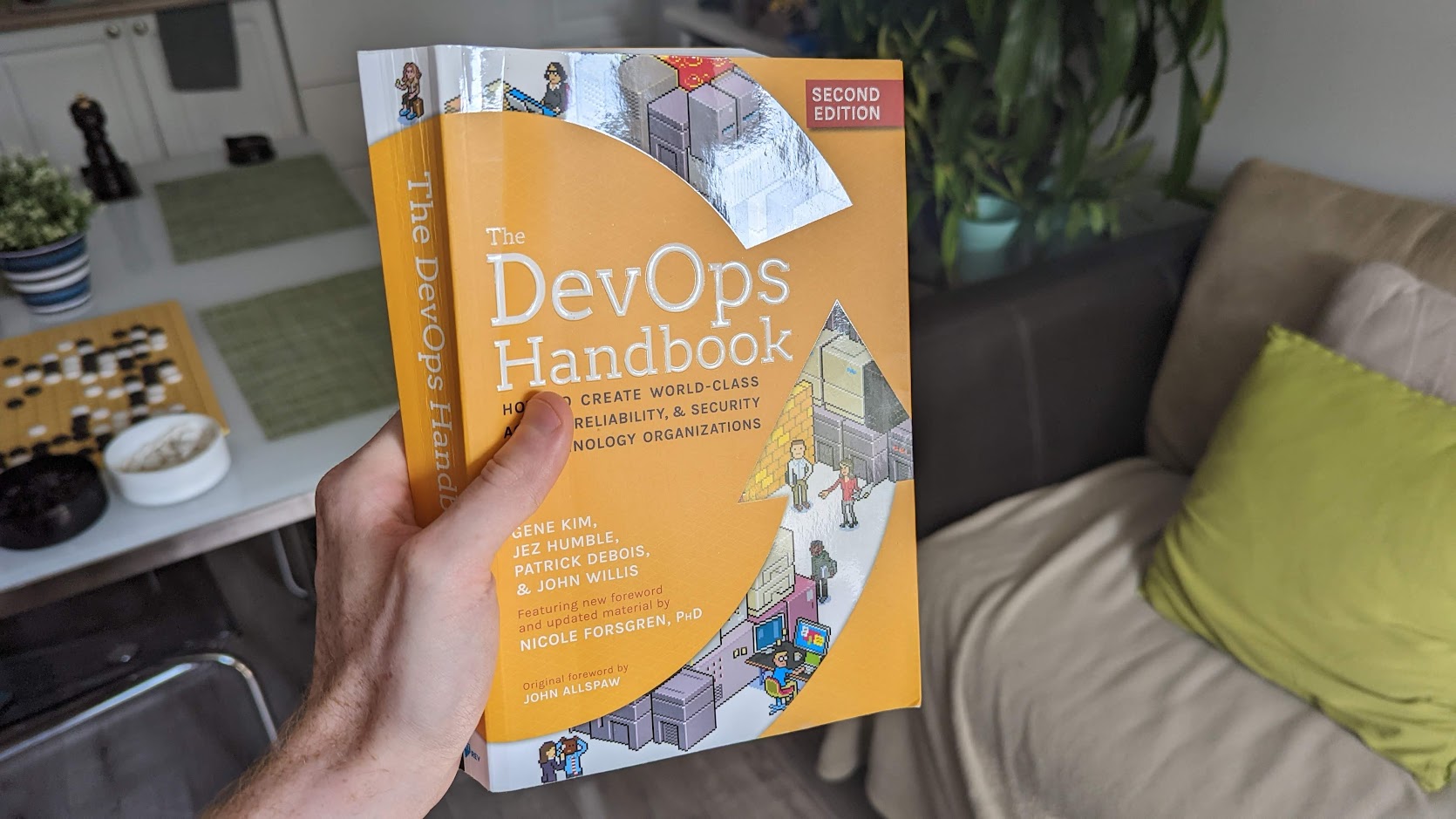
DONE!
Can you spot it? The little detail that allowed me to read the book? Look at the spine.
Do you notice how curved it is? Isn't that simply wonderful? It reminds me of skid marks on a race track.
I guess I must explain. See, I have developed a very recent fondness for curved spines (at least, on books). I used to think having a book with a curved spine meant you weren't taking care of your stuff. As if it was folded due to negligence, from being dropped and thrown around regularly.
Today, I realize there are good folds, and there are bad folds. A bad fold is the kind of fold I described above: actual damage. The picture above is an example of a good fold: it is evidence left by someone who really put their energy into extracting everything there was to learn from a specific book. It's a subtle difference, but it means a lot!
For example, if someone was standing in a gym next to their punching bag, you would probably understand that whatever damage the bag exhibits went directly into making that person stronger. A person holding a folded book is pretty much the same thing.
Book Suplex - Opening Pandora's Box
It was my current manager (and mentor!) Mathieu Frenette who showed me a "tool" that I would be using for the rest of my life. It is a way of holding books that reminds us that our goal is to learn. I call it the book suplex, but I also give it other fun names like the inverse fold, or the broken spine grab. Here is what it looks like:
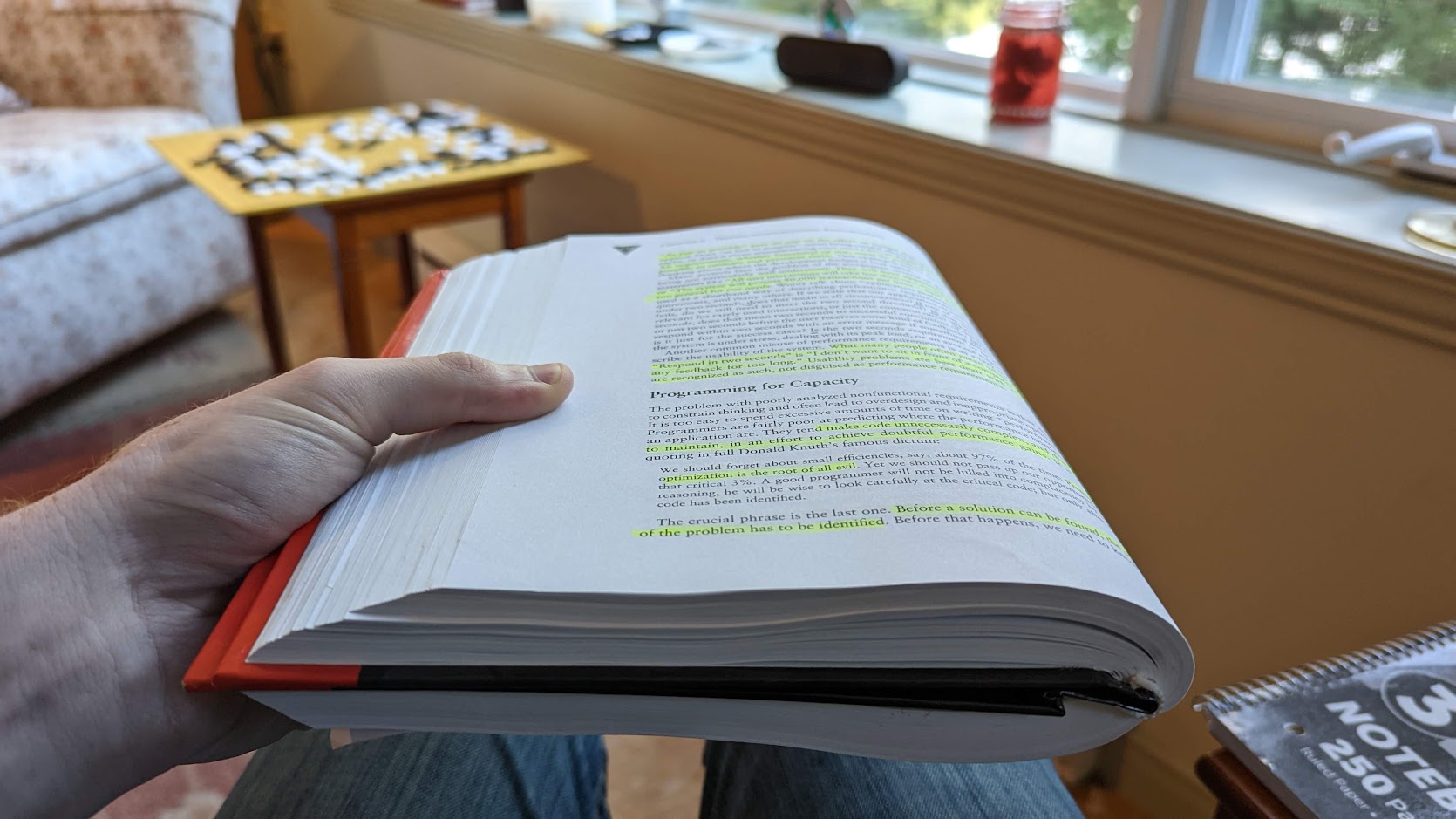
Suplex that book, even if it's a hardcover!
Some people might cringe when seeing this. Are you one of those? 😉
Yet, those who know, know. Now, you might be asking: What difference does it make to hold a book bent over backwards?
Personally, the book suplex taught me an important lesson: Books are punching bags. If they are damaged after you are done with them, chances are it's because you showed them who's boss.
A book is just a bunch of pages with ink on them. It is a book's content that is valuable, i.e. what sticks in your brain after you are done with it. The extraction process might leave marks, but that is secondary. Books are a mere tactile visual support. A suplexed book is not impacted at all in its capacity to teach us something. Yet, as obvious as this might sound, it is a truth that eluded me for many years.
(flashback)
About 10 years ago, I was a relatively money-poor grad student. I was relatively short on cash and keeping my old course manuals was not something I could afford to do. Thus, I took great care of my manuals, seldom highlighting or writing in them, in order to boost their eventual sale price.
Unfortunately, this strategy was sub-optimal. For an extra $40 per book sold, I was taking the risk of having a lesser learning experience. Without realizing it, I always saw my books as someone else's items that I was borrowing, or some item that might become desirable in the future, like Pokémon trading cards. This was so wrong. As a student, I was depriving myself of potentially useful learning tools in fear of wasting resources (money). I was like a boxer who was afraid to damage his punching bag. Maybe I had this mindset since I was used to owning collectible items (see how and why I got rid of my video game collection). Whatever the reason, I'm glad I made it this far in life despite this backwards mindset, because I don't plan on doing this ever again.
(end flashback)
So there you have it. Now you know why I believe a folded book is beautiful. It means someone probably gave the book the time and energy it deserved. And, indirectly, if this "damaged" book is freely available on a bookshelf near you, it means that person understood the book enough to part with it, and thought it was worth sharing with others.
Is it really a coincidence that a curved book spine looks like a smile? 😃
Creating a system of learning
So, knew how to hold a paperback book. Big whoop. This didn't change the fact that after reading 10 pages, I couldn't contain all the information I was reading. If 10 pages of info coming in my brain meant 10 pages of info coming out, that does not count as learning. That is the equivalent of passively listening to radio while driving. All your mind really records are the ads.
This time, something was different though. Folding my paperback opened Pandora's box. Now that I was unafraid to hurt the resell value of my book, a world of possibilities became accessible.
Attempt 1: Margin notes
I began by writing notes in the margin that I felt would make it easier to understand at a glance what a page was about. The reasoning was that whenever I pulled the book from my shelf, I would quickly find information as I flipped through the pages.
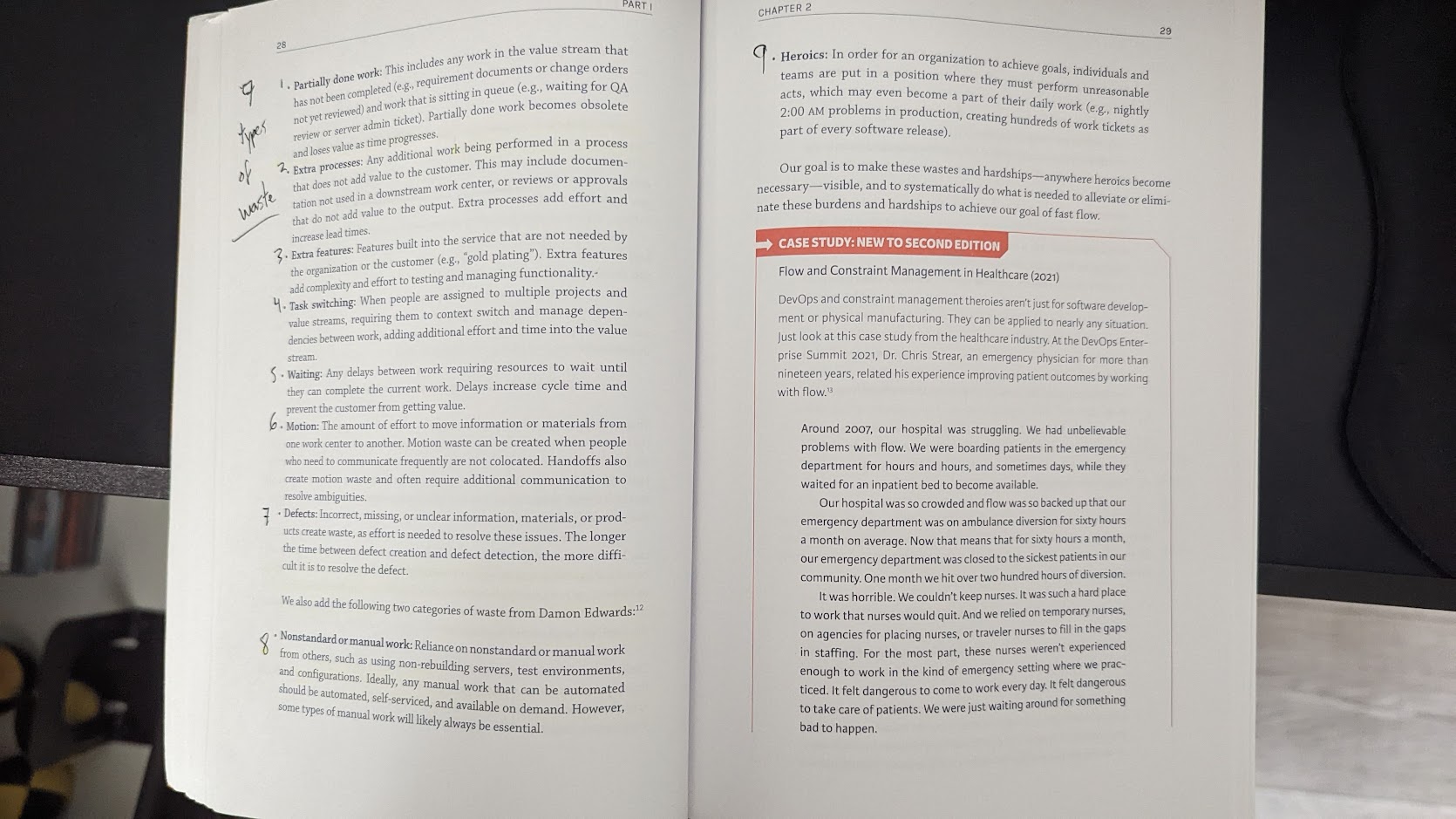
Unfortunately, that did not work. Why? Simply because I never took the time to go back to chapters I had already read. And this was supported by something my partner Gabrielle told me, as she was completing her PhD: "You never want to read the same book twice". As a fan of novels, this was something I initially disagreed with. Indeed, well doesn't love going back to a book that brought them great joy? However, I came to understand what her statement meant later on: Reading a book twice is suboptimal and a potential waste of time. What does that say about the first time you read that book?
In short, we obviously want to learn things right on the first run-through, so planning on going back to the book is an anti-pattern. Unfortunately, I was still a slow learner...
Attempt 2: Highlighting
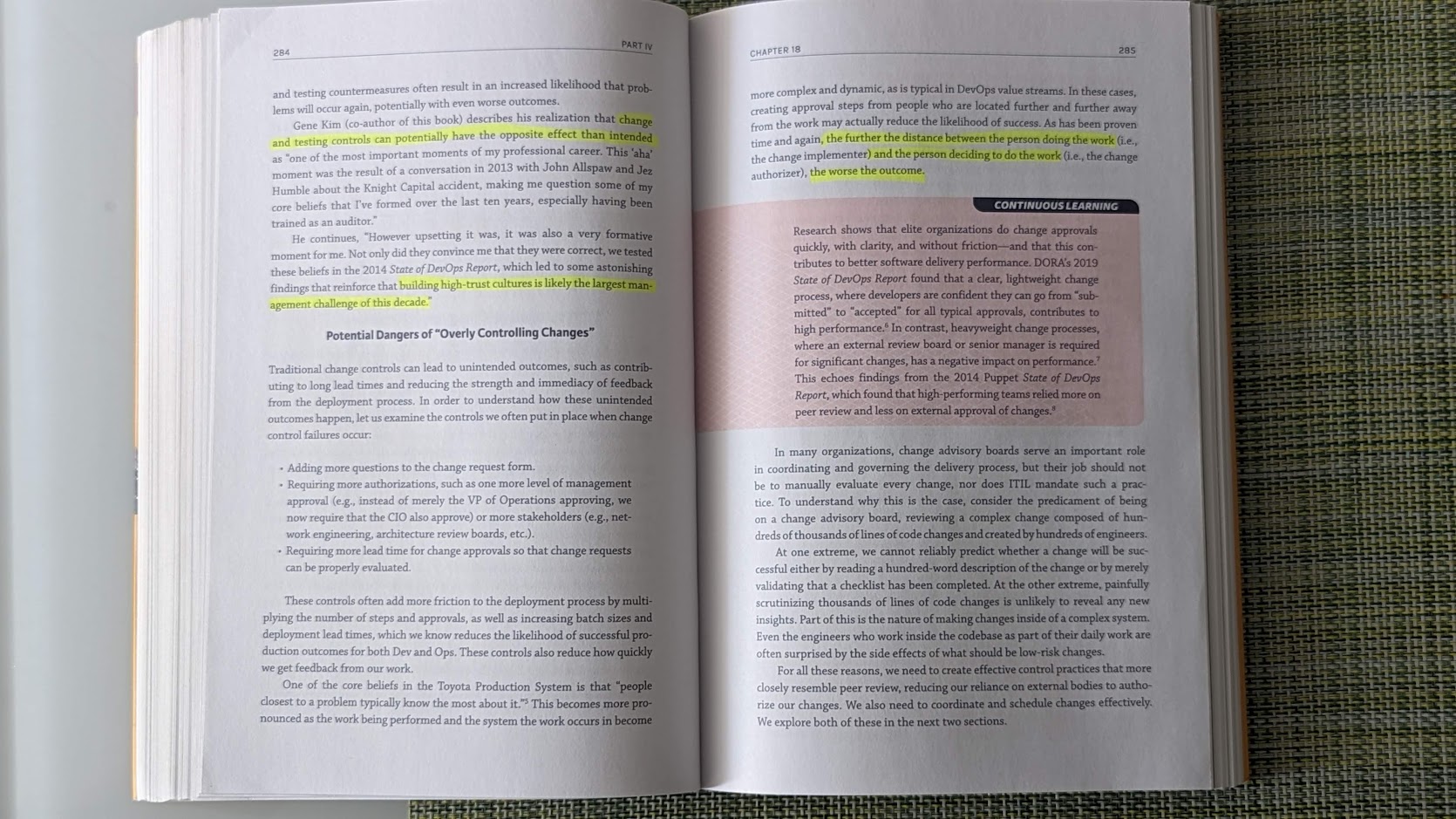
Gold nuggets of knowledge!
Armed with a highlighter, I had an idea: If a book is a goldmine of information, my highlighter will allow me to illustrate where the actual gold nuggets are.
Indeed, not every word in a book is going to be useful information to you. It is up to you to determine what information is worth going back to or not.
However, once again, I faced a problem: What good was it to highlight in a book if that meant I had to keep going back to the book to find these nuggets, or worse, re-understand the context in which that nugget made sense? Again, I could hear Gabrielle's wise statement in the back of my mind: "You never want to read the same book twice."
Duh! Ok, the third time is the charm.
Attempt 3 (eureka!): Record knowledge in a journal
After feeling like I was on the right path but struggling to find a system that works, I started searching the internet for ideas. How do fast learners learn? That is when I found this video from Matt Morris, which outlined the system eerily close to my current system of learning, and which helped me overcome my learning anxiety:
This video was life-changing.
In short, Matt's strategy is the following:
Material needed:
- Book
- Journal
- Pen
- Highlighter
While reading:
- Look for the golden nuggets of information
- Highlight the important bits
- Rewrite it into your journal
- Reread your journal, highlight important bits
The idea behind this system is simple and fixes you to work smart. Books do contain answers to our questions - that is why we choose to read them after all! However, they also contain a lot of context to explain why certain knowledge nuggets have meaning. What if we simply recorded the nuggets that we want to remember, and ignored the rest? Forget the fluff, literally!
Indeed, grinding through a book takes a lot of time, so we do everything we can to avoid doing it more than once. We want to capture information in a concise way that will empower us. A book might be a best-seller or a classic, you probably already have other books on your bucket list that also call for your attention. No time to go down memory lane. Give a book the time it needs, then be done with it. For real.
Following this basic method already sent me down an excellent path. My own learning system naturally evolved from there.
My current learning system
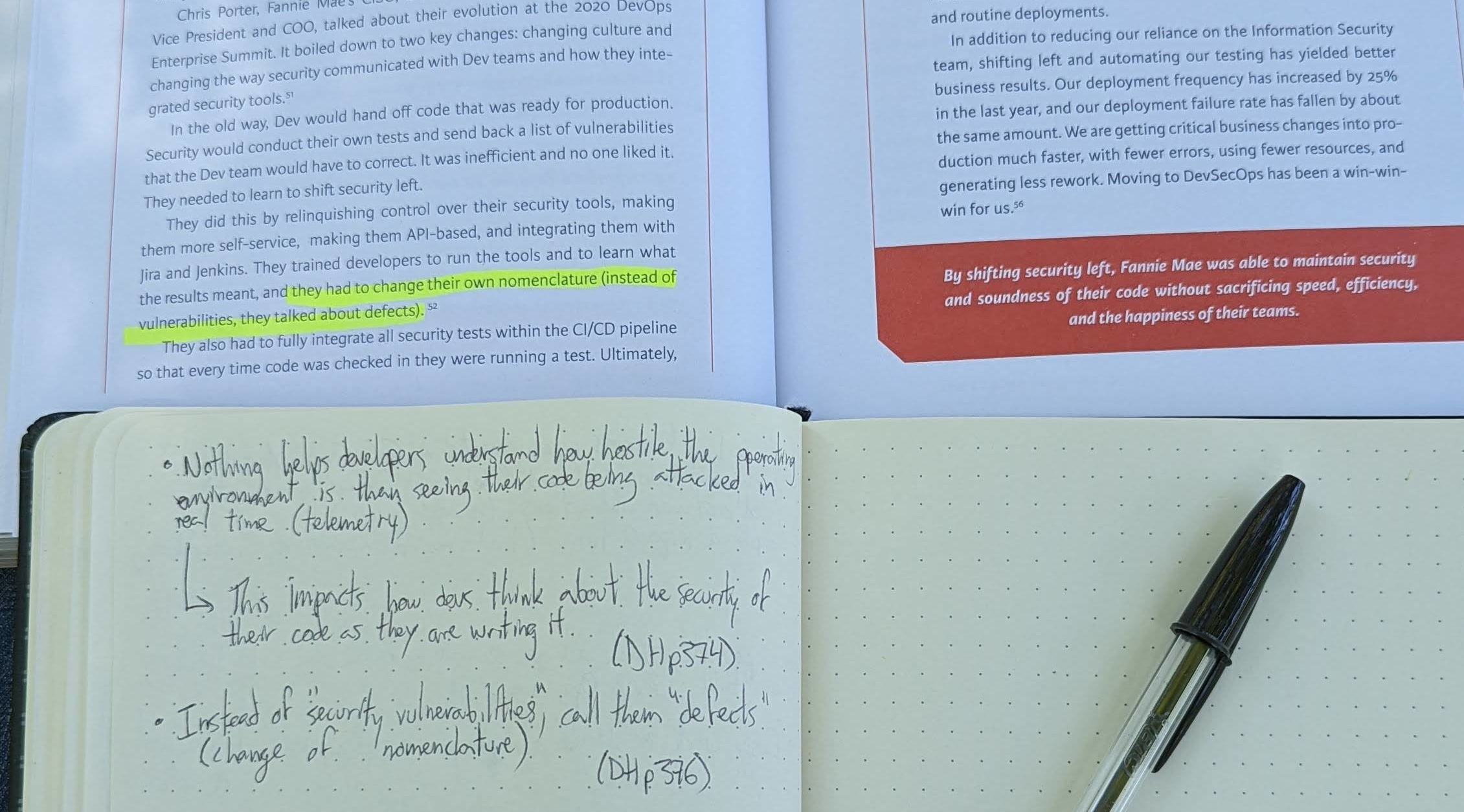
The core idea stays roughly the same as Matt Morris' strategy outlined above. However, there are subtle details that make my method work for me:
Make a clear distinction between "books" and "novels"
My system only applies to books, which contain material from which I aim to learn. By my definition, books are not designed around entertainment, unlike novels.
The Phoenix Project skirted that line brilliantly and I think that can partly explain its incredible success. However, in most cases, before you start reading, you should already know what system of rules will apply by answering questions such as:
- Do you allow yourself to quit that particular book before finishing?
- Do you consider reading this book a personal project, or entertainment?
- Will you search for knowledge nuggets while reading?
Personally, I read books in physical form, and novels in digital form.
I know, I know! I used to say that physical books had no reason to exist, but now my stance has softened: for books aimed at learning in the workplace, paper is almost quintessential, because you can physically annotate it, and then pass it along to your co-workers. It becomes both a trophy and a reference tool. It makes learning visible and tactile to everyone.
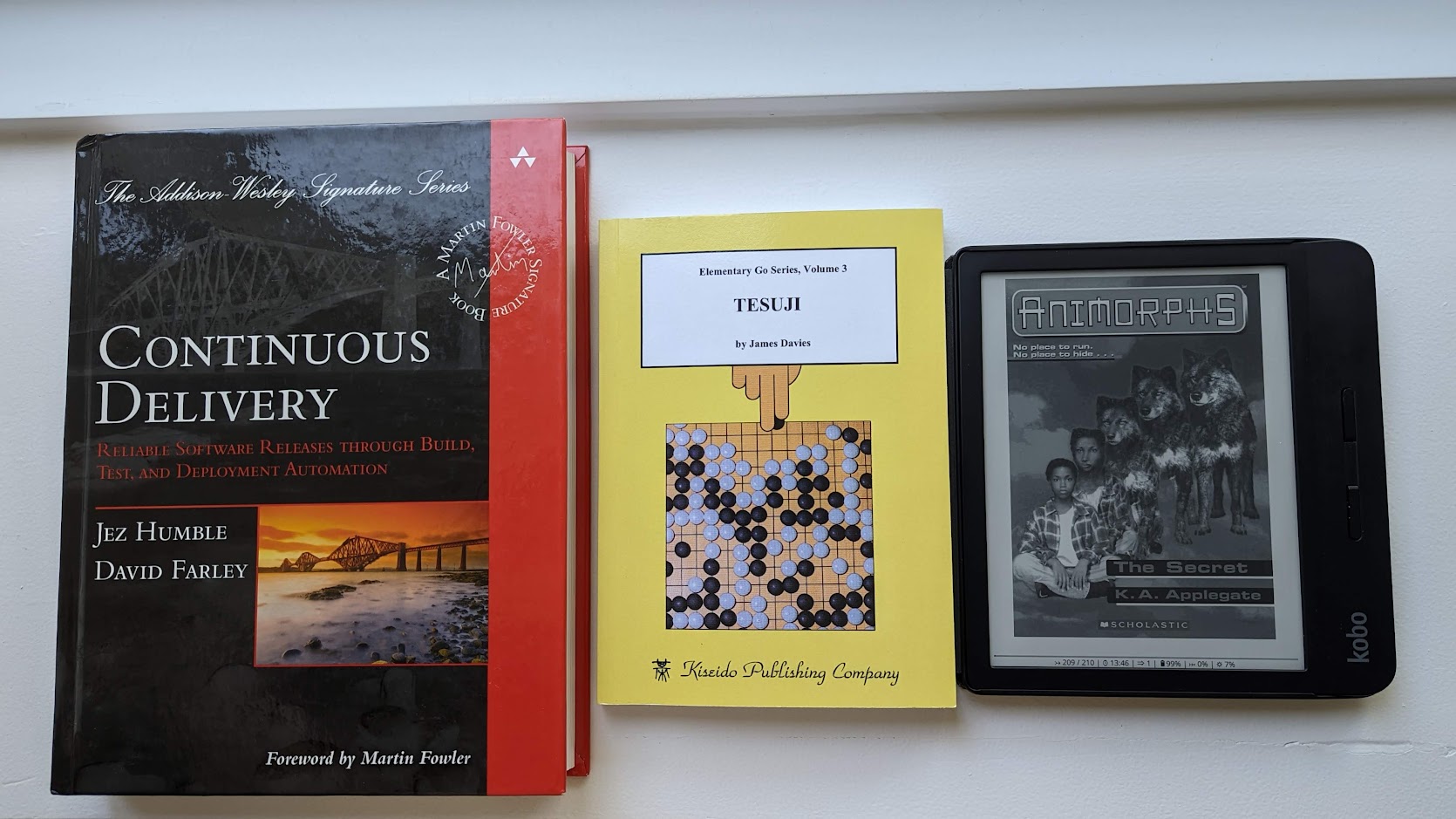
My current reading list: a book, a Go book, and a novel.
Read a single book at a time
As you start learning, you get excited when you see all the possibilities within your grasp. Never forget "Stop starting, start finishing".
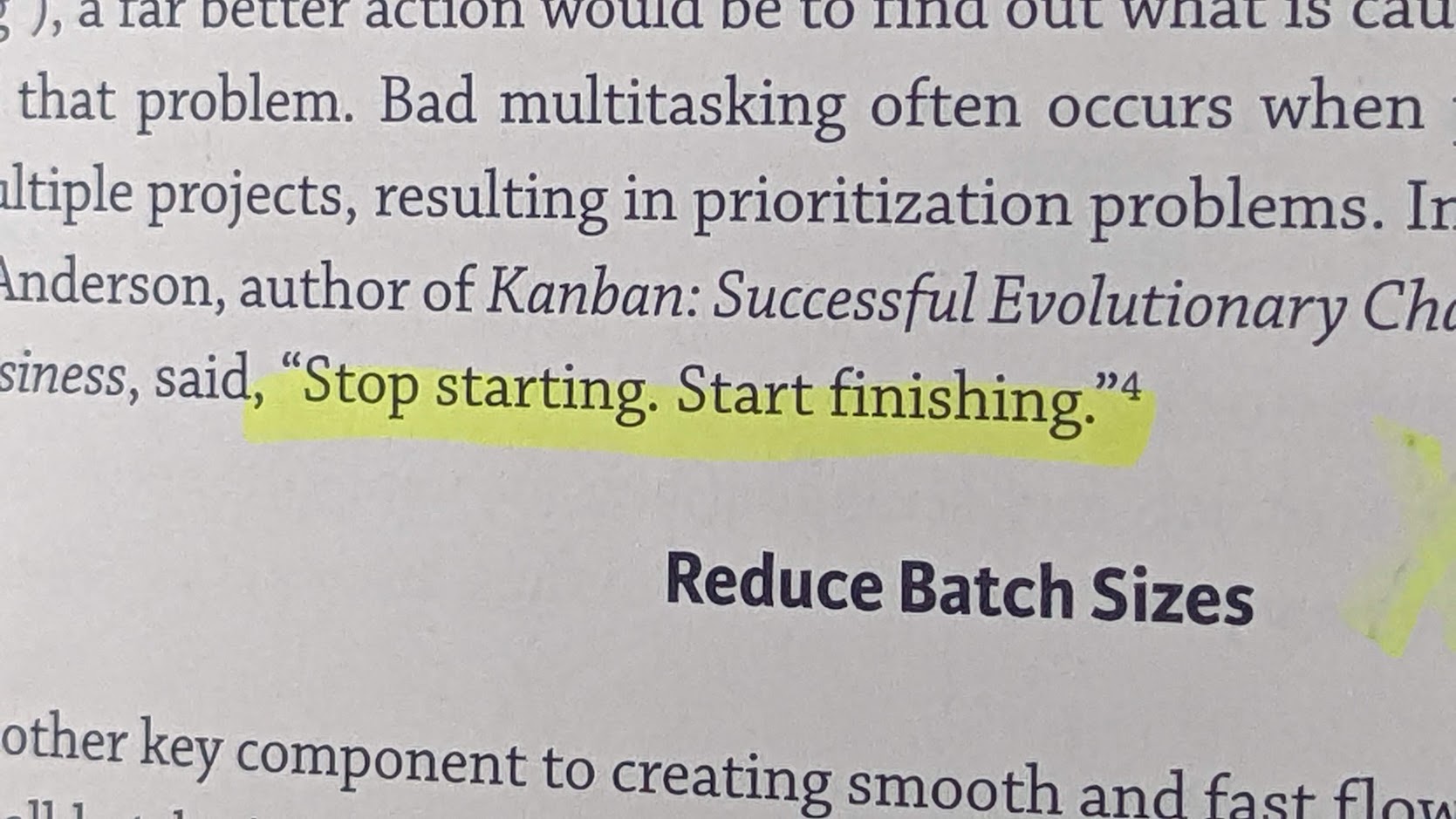
Words to live by.
Choose your book well, and don't start another one before you finished your current one. Use this as motivation to get through your current book, if needed!
Personally, shelving a book without finishing it only leaves me more confused. It gives me some pieces of the puzzle, but since I lack pieces I will never see that puzzle to completion. Bite the bullet, and finish the books you start, unless they are novels that fail to grab your attention.
Wait until you are in the final pages of a book before ordering your next one. You don't want to make commitments that you might not be able to complete. I strongly advise to order only a single book at a time - don't get carried away!
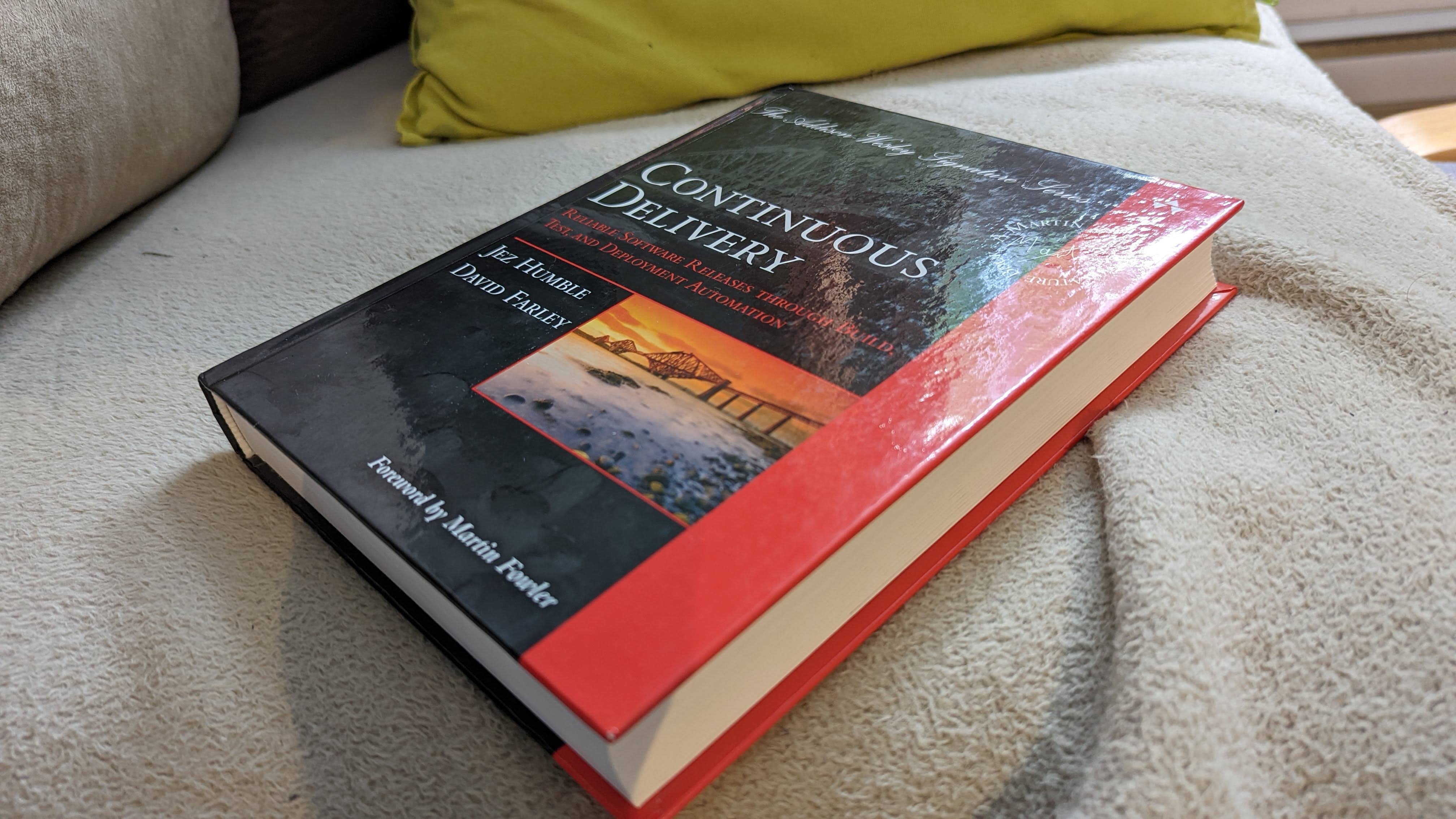
This is the next book I'm tackling. It has been on my radar for years. I finally feel ready to give it an honest try.
Note: Reading a Go book on the side is ok, although I recommend reading a single Go book at a time. 😄
Schedule (and respect!) your book time
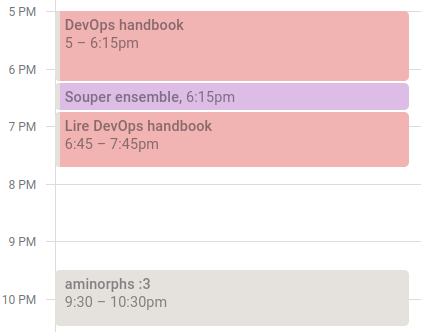
This tip is so important that it could be its own blog post (and it probably will).
How fast you learn is directly proportional to the amount of time you are ready to invest in your learning. What I'm starting to find out is that time is like money: Whatever amount you don't actively invest in yourself has a way of vanishing in mysterious ways.
Personally, I try as much as possible to schedule my reading sessions in advance. This has multiple benefits:
- I can move other events to make sure I have enough time to read
- It reminds me of the actual quantity of efforts I put into my learning
- It informs my partner when I am focused and need my own space
If I feel like I'm learning too slowly, all I have to do is put more time in my schedule to read.
Interestingly, this scheduling process made me realize I had much more free time than I thought. As reading began to make me feel relaxed and empowered, it mostly replaced my other time wasters (YouTube, Reddit, Twitter, video games, complaining, ...), simply because it became a joyful, reassuring part of my day. In short, reading, i.e. learning, started to feel like knitting. When I read, I shut out the whole world and just focus on my task, almost on auto-pilot, similar to someone watching TV. The difference is that reading (and writing!) for an hour makes me feel both powerful and calm, unlike watching Coffeezilla or the CUPodcast on YouTube for the same amount of time.
We are all equal when it comes to time. On average, our weeks consist of roughly 110 awake hours, of which at least 40 are taken by our jobs. If we squander our weekly remaining 70 hours week after week, no wonder we feel like we are accomplishing nothing. These 70 hours are all we have in our "time tank". Life has no mercy when it comes to time, so we have to make sure we plan ahead in order to be able to spend our time in a way that is truly meaningful to us.
Personally, I aim at spending at least 6 hours reading or taking notes weekly. It can be while in public transport, after dinner, at the park... When I'm washing the dishes, I try to watch videos that can help me learn (e.g. Why Scaling Agile Doesn't Work by Jez Humble). Any second I can spend learning is time well invested, especially now that I have a system that works for me.
Invest in a bound journal
Alright, we are now getting into the tips you were probably looking for. What hardware do I recommend?
First off, this is probably basic common-sense, but I'll make it explicit, just in case: Don't use a spiral-bound Hilroy notebook or, worse, a stitched exercise book. These won't do much good here if pages keep tearing and falling out of your journal after a few years.
Some features that I personally look for when buying a journal:
- B5 size - not too big, not too small.
- comes with stickers for the spine and cover to easily identify in my library
- dedicated space to write contact information (if lost)
- table of content
- numbered pages
I currently write my notes in a TRURED notebook I found at Staples (Bureau en Gros) which cost me $10. It was the cheapest dotted bound journal in the store. It didn't have all the features I listed above, but I worked around that easily.
I also bought a Leuchtturm 1917 A5 to use as a personal diary and I liked its features, feel, and available colors, so I think the Leuchtturm will be my notebook of choice going forward. Moleskin gear seems slightly overpriced, but I admit I have not tried it myself.
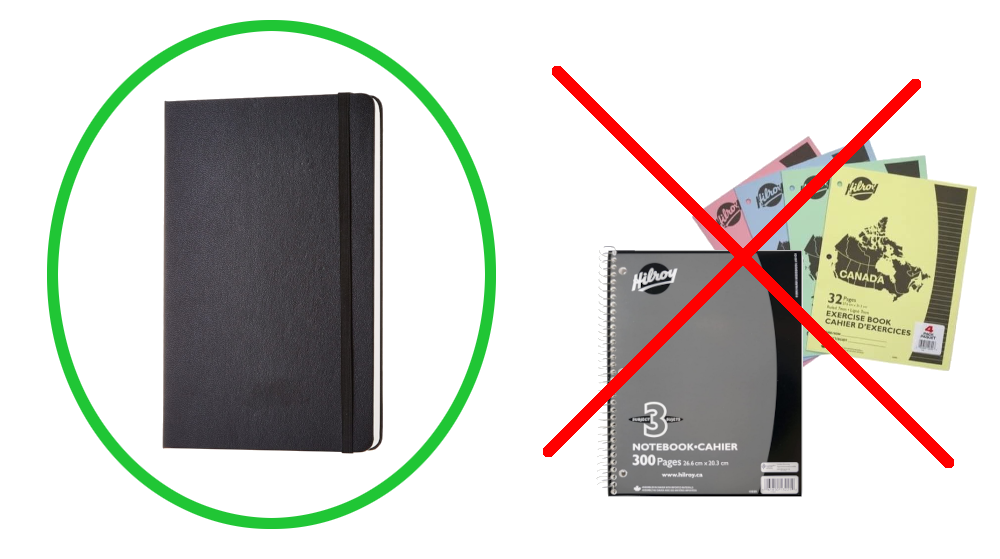
Note: Some people enjoy spiral-bound notebooks because they allow to easily fold back the notebook and stay opened flat on a table. If you do invest in a spiral-notebook, at least make sure it is high quality.
Use a grid or dotted journal
This allows better horizontal alignment of information for writing lists. It makes my messy handwriting look less messy. Personally, I am now very fond of dotted journals, because they provide the benefits of a grid without being as visually distracting.
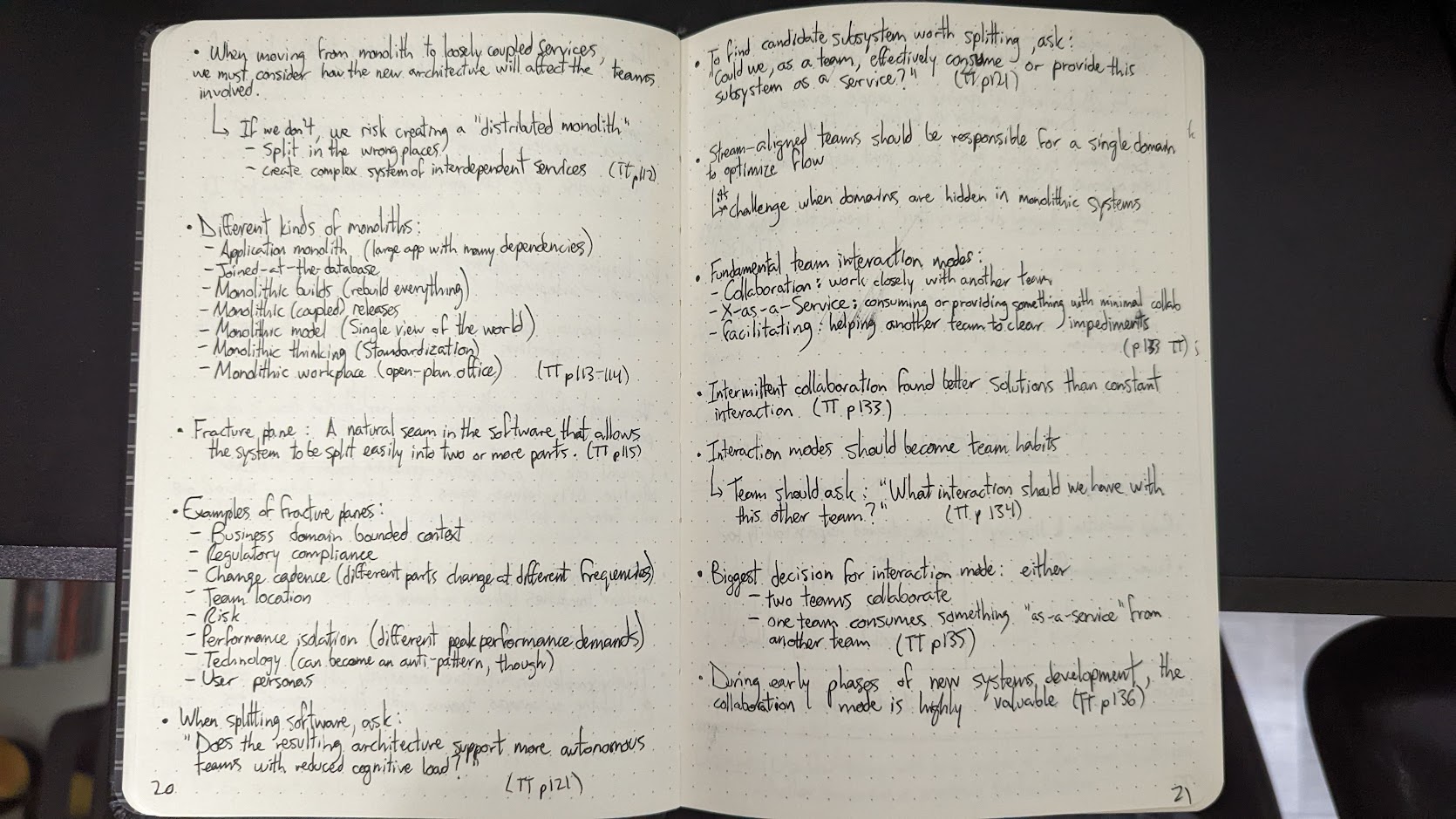
Number your pages
If your notebook doesn't have page numbers already (most don't), I strongly recommend that you number your pages yourself. This is invaluable to allow you to reference your notes later on. It is such an integral part of my system that I initially forgot to list it here! This is a quality of life upgrade that is too obvious to live without.
Take the time to shop for pens and highlighters
Story time, as this is a subject that is near and dear to my heart.
For the longest time, I did not care about the writing material I used. I was perfectly content with whatever pen I'd find on the ground or have given to me by my family, my friends, or my workplace.
What I didn't realize is that there is no one-size-fits-all pen. What works for you might not work for me, and vice versa.
For example, the first pen I bought this year was a Pilot G-2 07. I was tired of the worthless pen I was using at home for journaling and taking notes. I just went to the pharmacy and grabbed whatever black pen looked good in the Pilot display at my local pharmacy.
Luckily, the Pilot G-2 was definitely a step up from the pen I was previously using:
- Deep dark ink
- Effortless glide
- Satisfying clicky button
But it also had cons:
- Empties quickly
- Smears!!
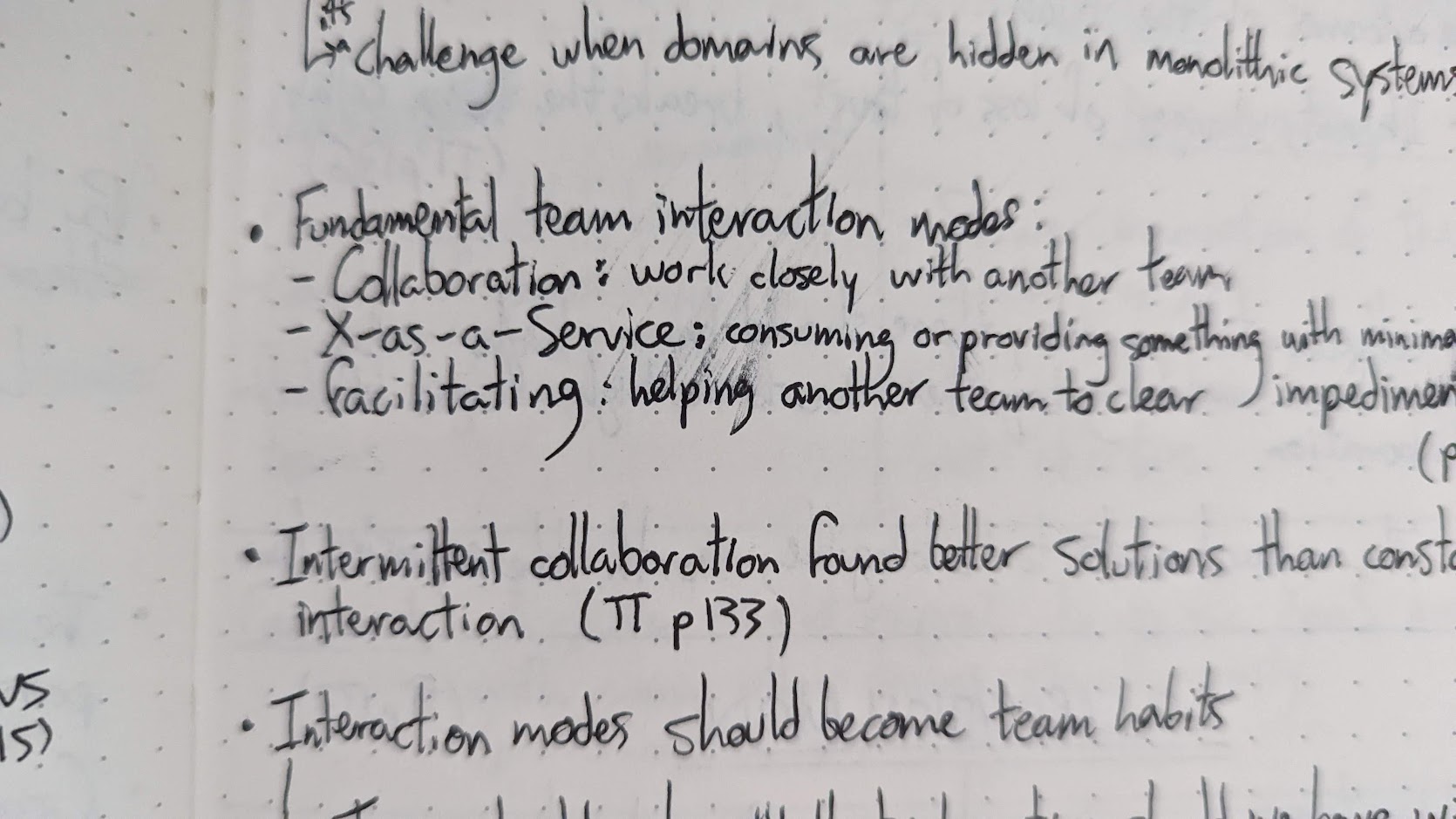
Smears! I hate smears.
Being left-handed definitely didn't help with smears. Thus, the search for my pen of choice began, a pen that, no matter what type of paper I chose, would not let me down and would not definitely not smear.
Online searches seemed to center on three candidates:
- Pilot G-2 07 (which I already knew was not for me)
- Paper Mate InkJoy
- Bic Cristal
I went to my local pharmacy and saw bags of Paper Mate InkJoys and Bic Cristals, similarly priced at 10 pens for $3. "Screw it", I said, and I bought both. That is the best $6 investment I have ever made.
I proceeded to write an entry in my personal diary to test the pens. After a couple pages, the results were in: The Bic Cristal ticked all the boxes for me. Although its ink was paler than I would have liked, it was easy to push on paper, had a comfortable hexagonal barrel, and most importantly, did not smear.
Amusingly, the Bic Cristal is the most cheaply priced pen out of all the options I tried. The best tools are not necessarily going to be the most expensive, but you will never find the right tool for you unless you go out, search different options and compare them yourself. Don't cheap out on this step - these are your learning tools. Invest the time required to find the pen and highlighter that makes writing a joyful experience for you.
Thus, if you're looking for recommendations, mine are:
- Pen: Bic Cristal (black or blue)
- Highlighter: Bic Brite-liner Grip
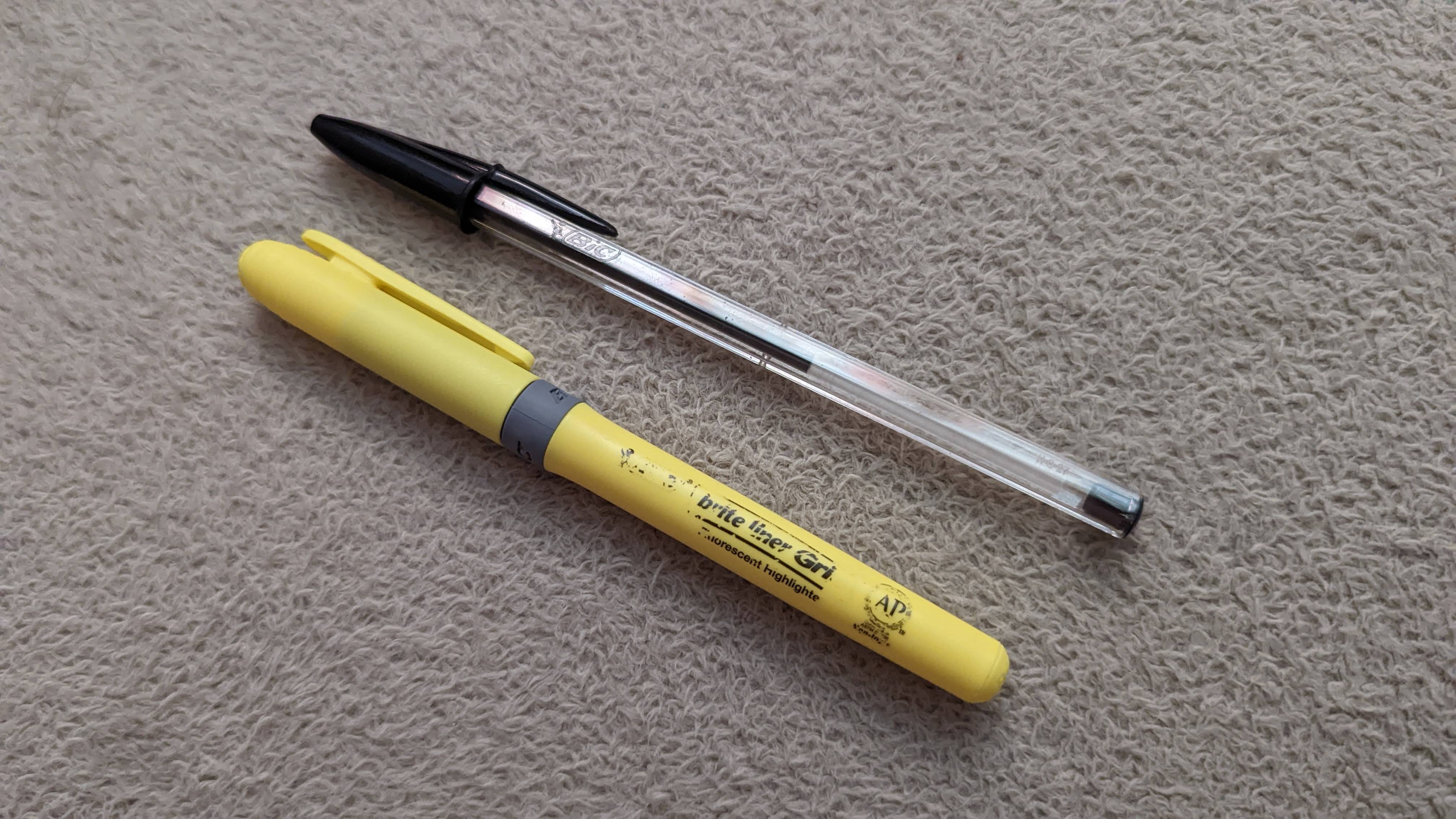
So, am I a good pen seller? ;)
Note: This process led me to learn about the history of the ballpoint pen, which was a fascinating read.
Note 2: I stumbled upon this video about the Bic Cristal from Joe Van Cleave who, like me, is enamoured with his Bic pens. This is what we're aiming for: finding the tools that genuinely make us excited to get to work to use them.
Note 3: Interestingly, for drawing on human skin, the Paper Mate InkJoy is surprisingly hard to beat. I will not be answering questions.
Have a ruler handy
This allows you to make nice lines, for tables or underlines. Any cheap 15 cm ruler will do. It makes your journal more pleasing to read, which is important. After all, the whole point of keeping a journal is so you can easily refer to your knowledge.
The best storage place I found for my ruler is directly in my notebook. The book's elastic band keeps it securely shut.
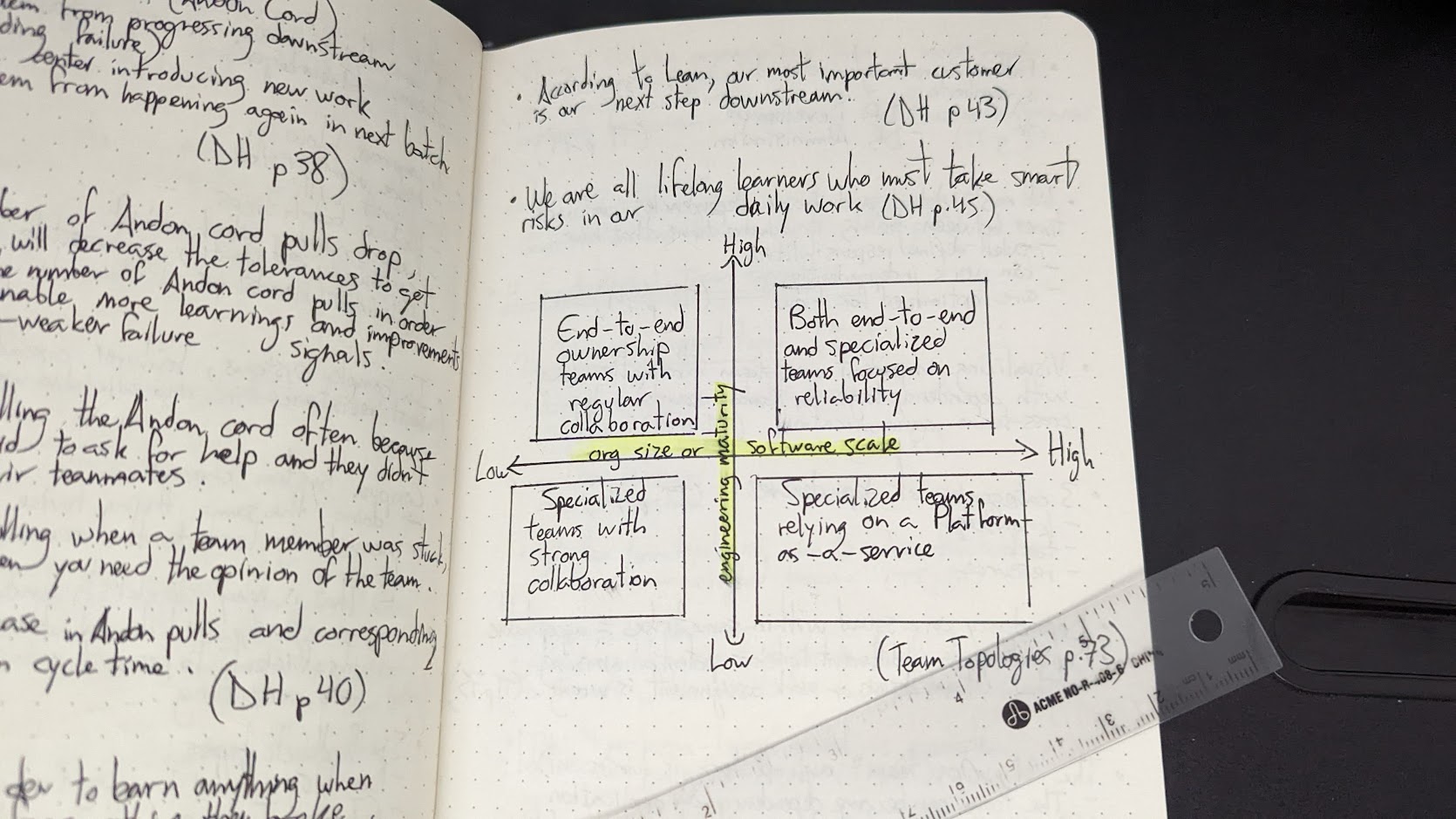
Make your own margins!
For most of my life, I assumed the margin was meant for graders to review your work and comment on their corrections. Well, news flash: the margin is for everybody!
As you can see from the struckthrough tip above, my system is constantly evolving. Leaving two empty lines between each note is a passable trick, but it still feels a little cramped. The best use of space is to use margins.
It's a shame that most quality notebooks that I know of don't have margins. Use this to your advantage: make your margins as wide or as thin as you need.
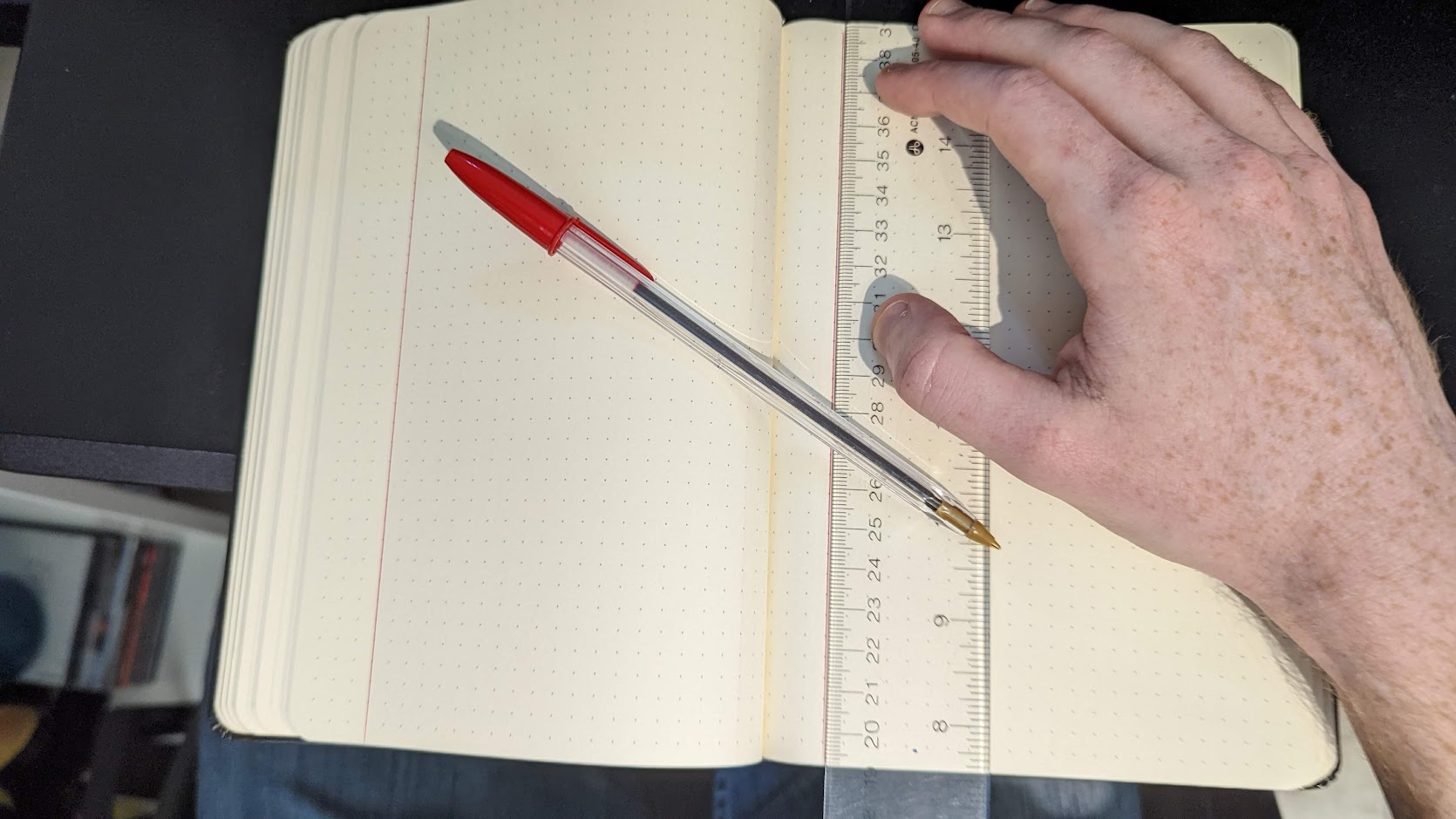
Ironically, I rediscovered the usefulness of margins after using a Hilroy notebook to take notes during a day of work (I had forgotten my workbook at home).
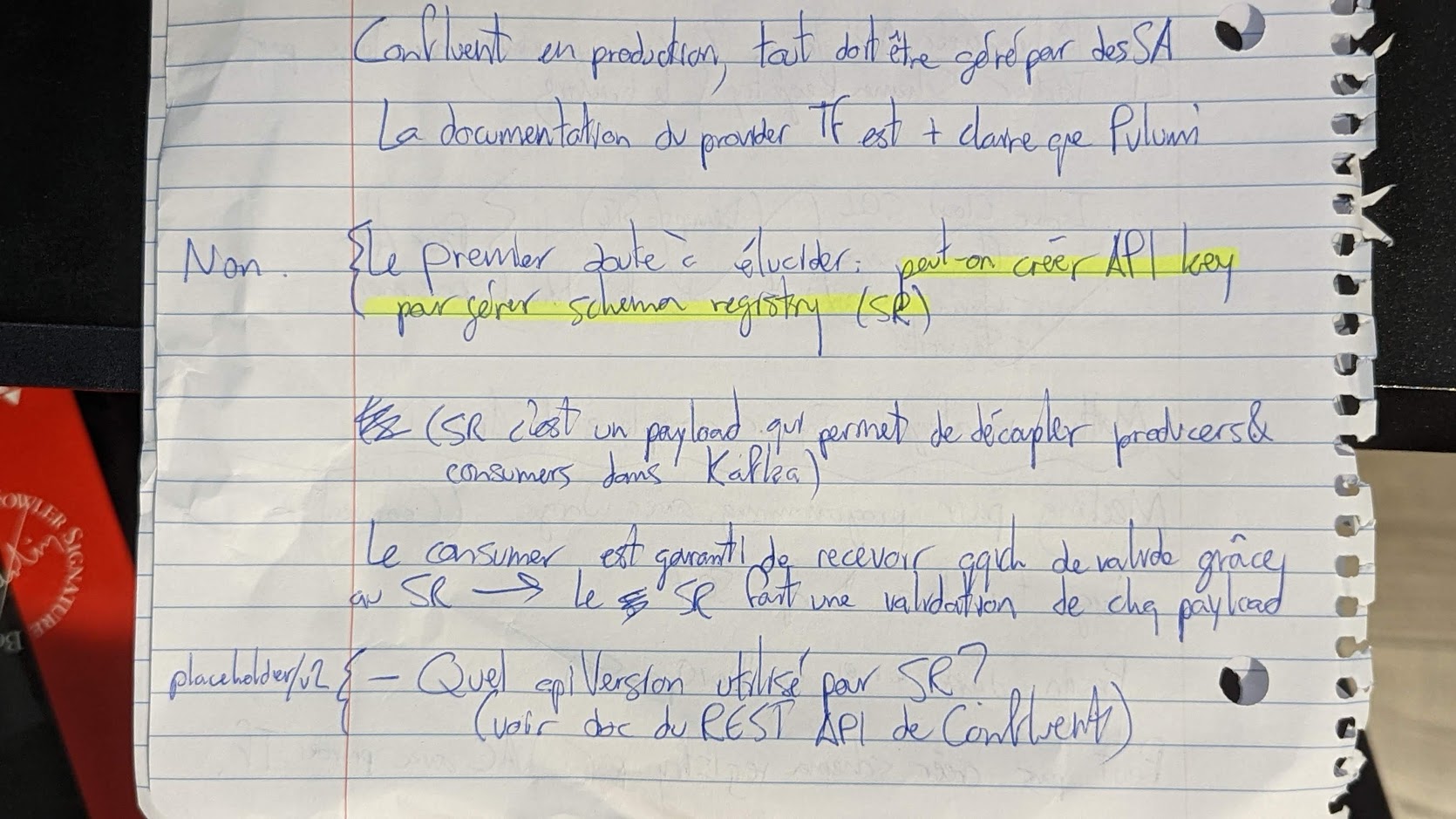
The legendary Hilroy margin was staring my in the face all this time.
In my notes, sometimes I write questions or things that will need further updates. The margins is the perfect place to put such updates. Of course, not all of your notes will require a margin note, but that's a good thing: it leaves you with more room for the notes that truly need commenting later on.
Like numbering my pages, using proper margins is an absolute necessity to allow me to take full advantage of my notes.
Note: If this is the reason why each pack of Bic Cristal comes with a red pen, Bic managed to blow my mind once again.
Track your progress by folding the corners
This is a big part of my system.
I vaguely remember coming across an online debate about using bookmarks vs. folding corners. In the past, I would have been in the bookmark camp, but I'm now clearly a folded corners guy.
Each page has two corners and I use this to my full advantage. The top corner indicates my reading progress, and the bottom corner indicates my note-taking progress. And no risk of having your bookmark fall out of the book!
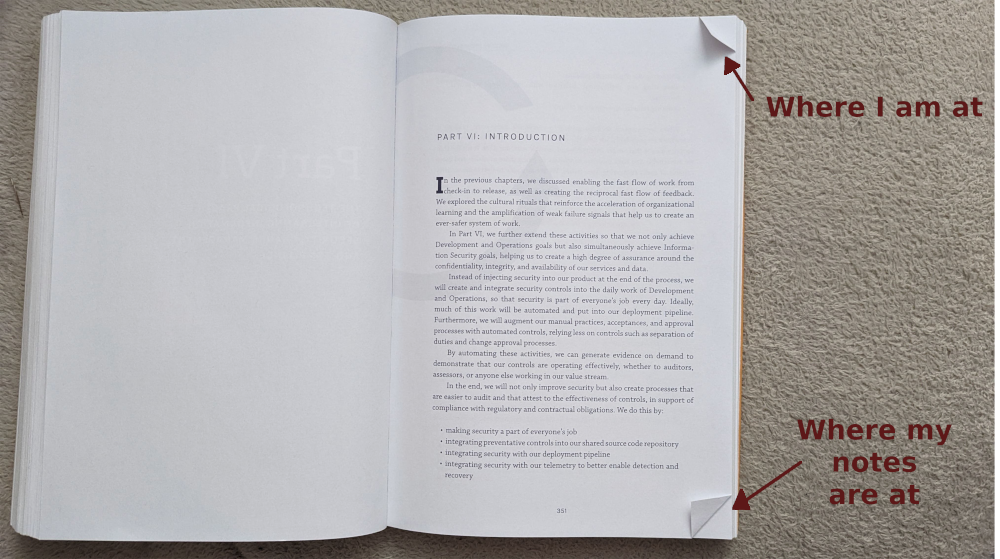
I can't overstate how useful this is. It make it feel like no moment spent reading or taking notes is wasted. Whenever something else needs my attention, I simply fold the corner, fully aware that whenever I'll come back to the book, I will know exactly what I was up to. Simply put, it reduces my cognitive load to a minimum.
I also like the fact that this transforms the act of learning into two distinct activities:
- reading
- writing
If I'm in the mood for reading, I read. If I'm in the mood for writing, I write. I feel like I am free to choose what activity is right for what time. And, most importantly, whatever I end up choosing, I am constantly learning.
Use the body of your highlighter as a visual aid
When I picture someone reading, I often see them using their finger to track their progress, like this:

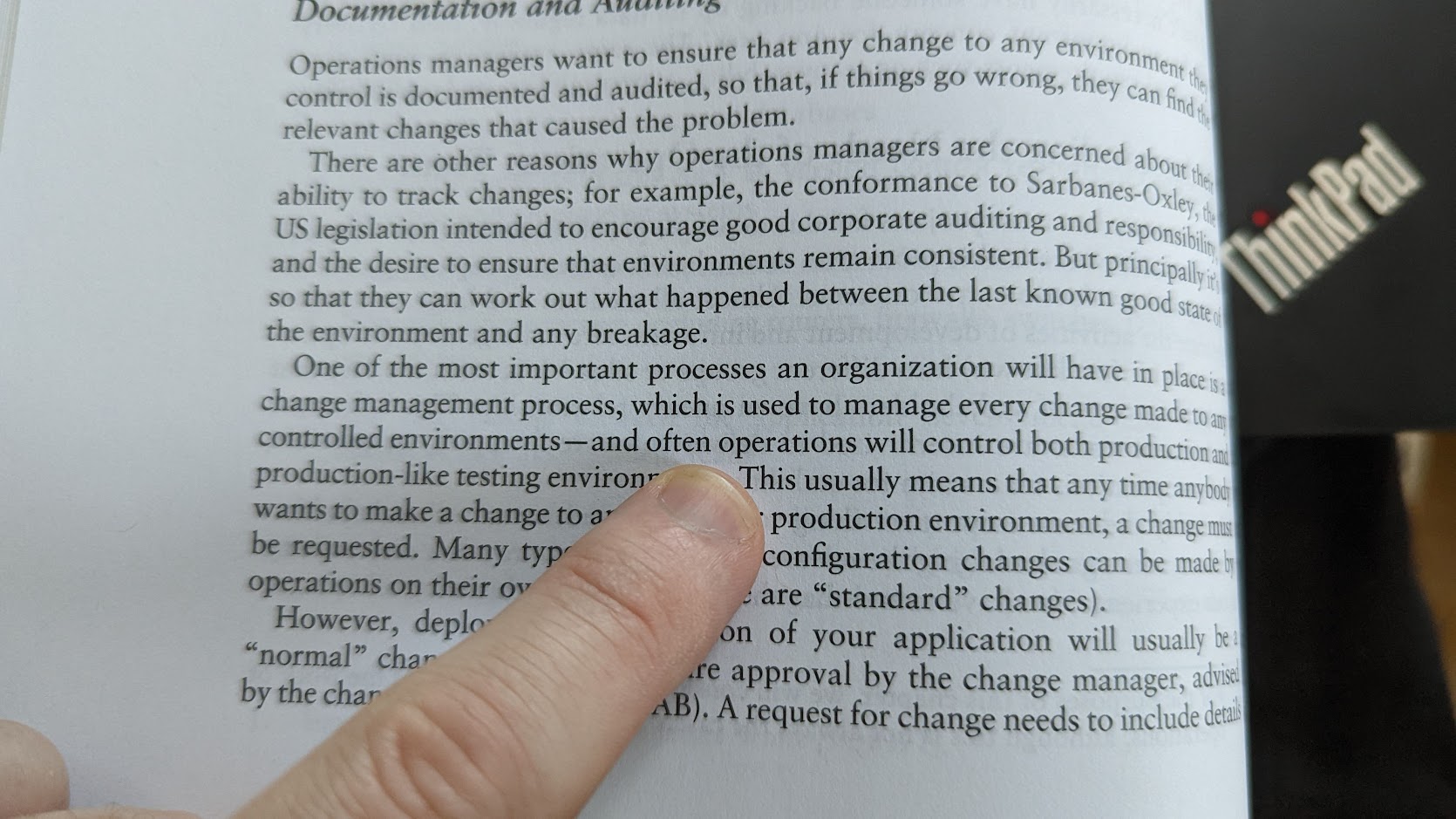
However, this method of tracking progress never felt right to me. There are many reasons why:
- My finger is too big to accurately point to specific words on a page
- To reach the full width of the page with my finger, I have to move my entire arm back and forth as a read, or move the arm holding the book. It wastes energy.
- I don't particularly appreciate the friction of the page on the tip of my index, especially over extended periods of time.
The method I now use to guide my eyes as I read is to use the full body of my highlighter. Since my system is based on Matt Morris' learning strategy, I always have a highlighter in my hands when I read, so this puts it to good use.
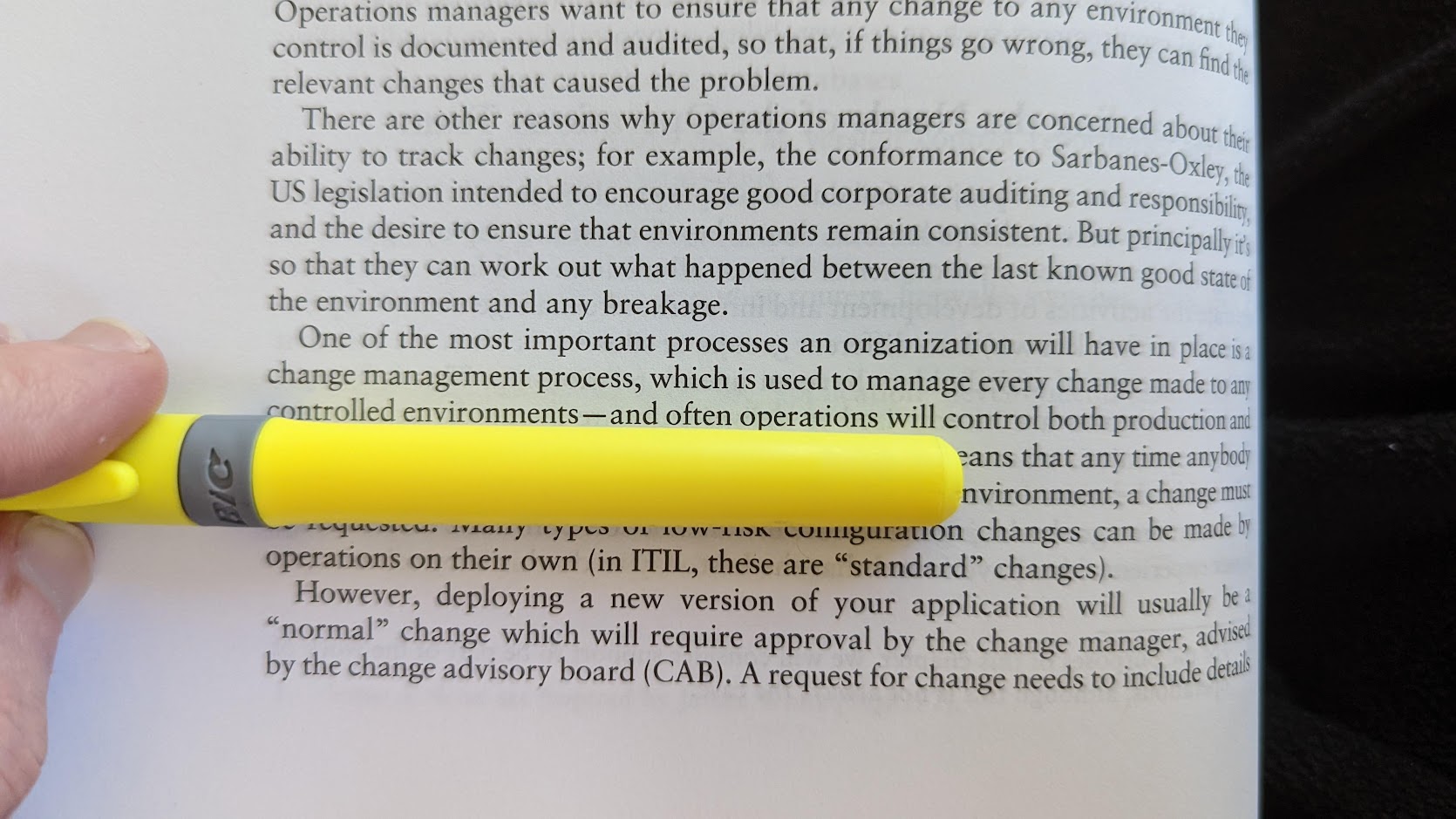
This has many benefits:
- Unlike the tip of your finger, the body of the highlighter is flat. It makes it obvious what line you are currently looking at.
- You can let your eyes glide along the body of the eye-lighter. It feels less jittery than following the movement of a finger, which can only point to one word at a time.
- The body of the highlighter is:
- long enough to allow me to reach the full width of a page within having to move my wrist, let alone my arm.
- vivid in color, which makes it quite eye-catching.
- wide enough to hide the sentences below what I am reading, which ensures I am not reading "in diagonal".
Identify elements of an enumeration
I noticed that some authors like to create enumerations in prose instead of in a list form. In order to help my future note-taking self, I use my pen to circle where each element of an enumeration begins in a paragraph. It makes the information much easier to parse later on.
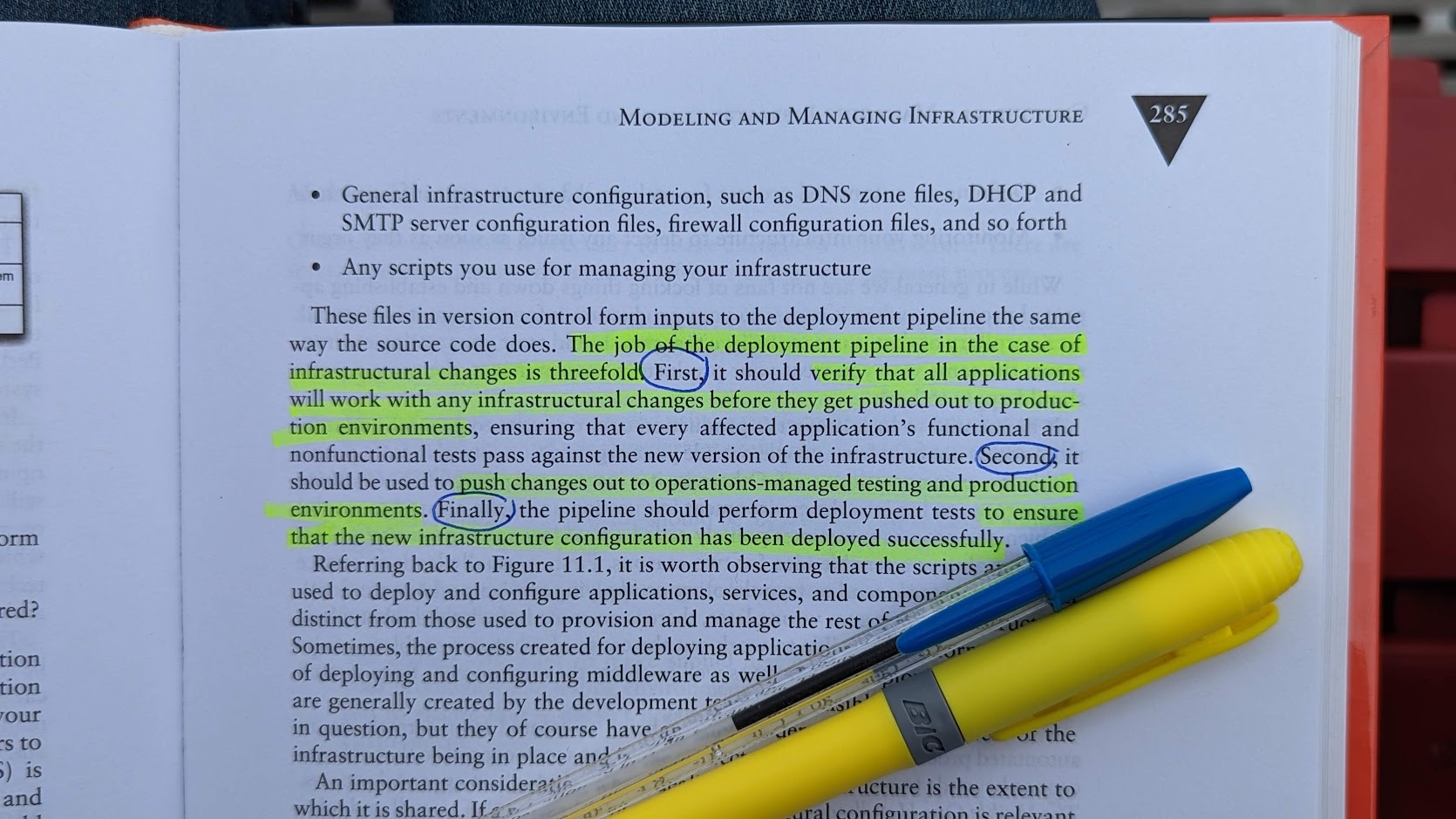
Use your book's margins to write ideas
If reading a certain paragraph triggers a lightbulb in your mind or makes you pause and wonder about a specific question, I recommend that you write that thought in the margins next to the paragraph that inspired it. That way, when writing your notes, you will also be able to record your own good ideas.
Don't let a good idea go to waste!
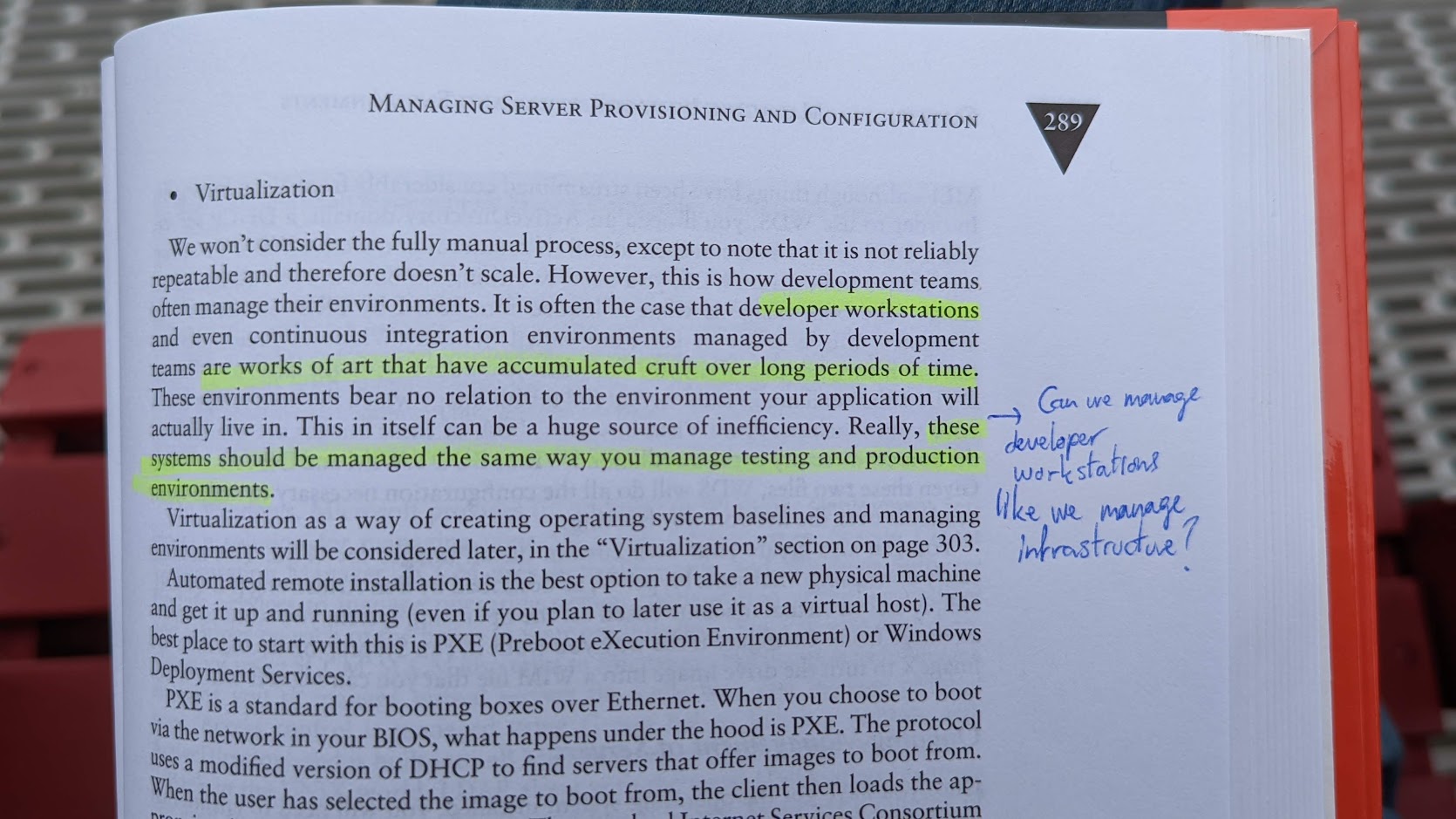
Note: To me, this type of margin note is subtly different from the type of margin notes I discussed previously, because it consists of new ideas, instead of being an attempt to summarize a paragraph. A paragraph summary should live in your notebook, where you will read it later to cement your learning.
Write the source of your knowledge nuggets
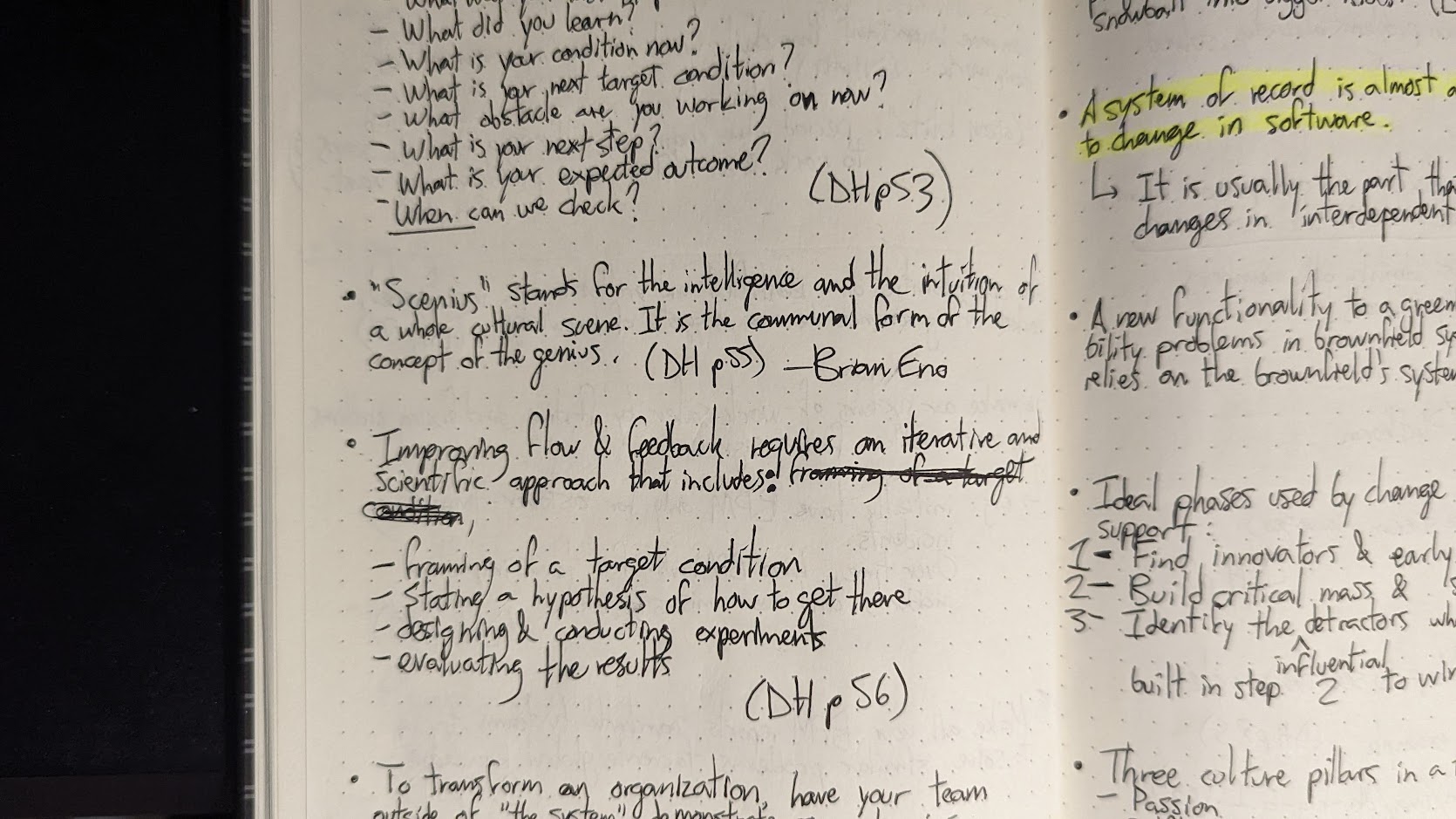
Notice in the photo above that most "knowledge nuggets" end with a reference to the source material. This helps finding context or correcting notes in the rare cases where your notes are unclear and you must refer to the book. Trust me, it can save you a lot of time, and also makes sharing that nugget in the future even easier (e.g. "As the DevOps Handbook says on page 49, improvement of daily work is even more important than daily work!").
Side effects may include people calling you a bookworm.
Have a book reference at the beginning of your journal
As you add more and more knowledge nuggets and references in your journal, it is going to be helpful to know at a glance from which books your nuggets were captured. I solve this by providing a list of books I read at the beginning of my journals. This is also useful to remember what the acronyms I use to reference a knowledge nugget stand for.
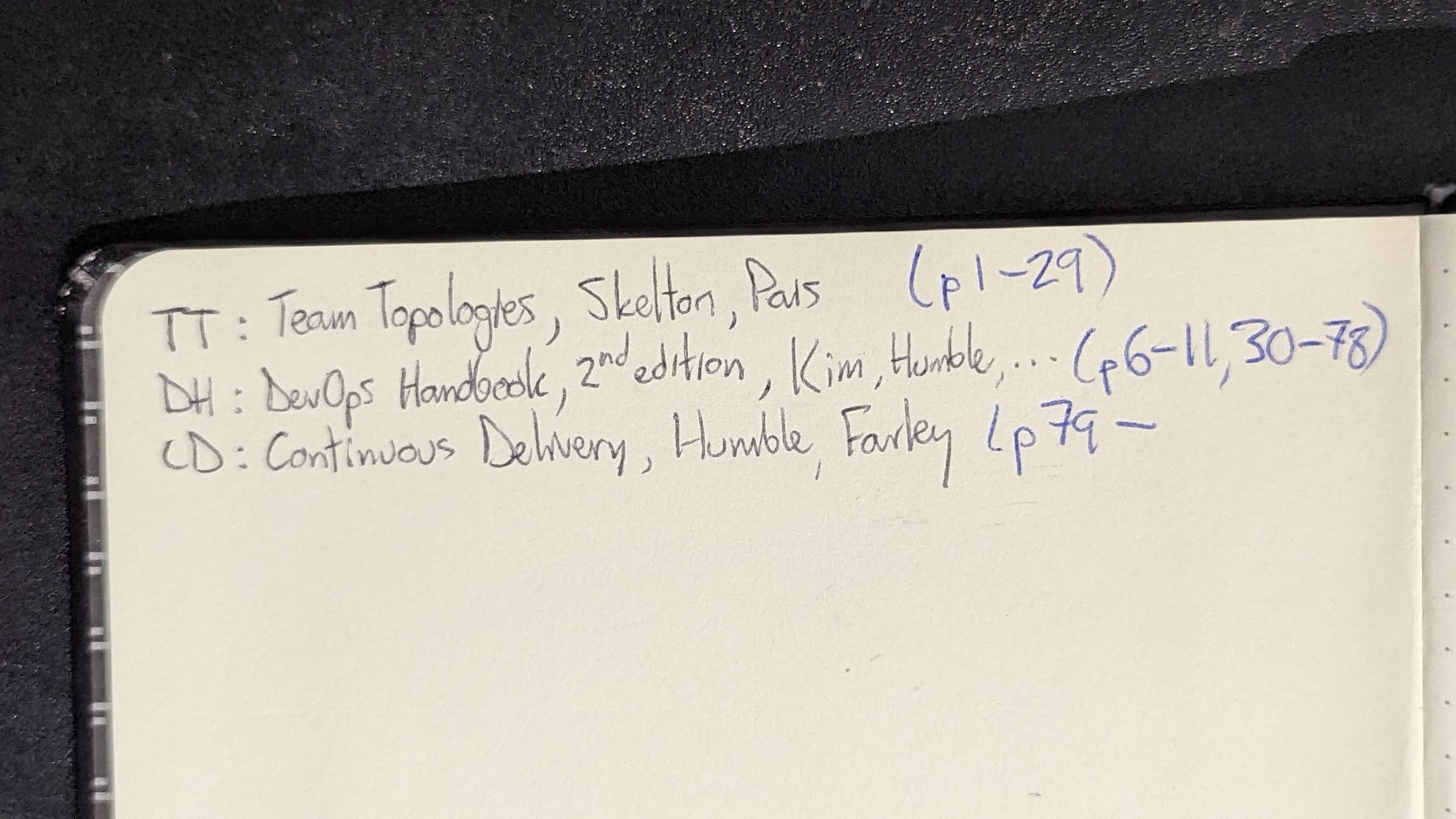
Have an index at the end of your journal
Eventually, reading your journal will take as long as reading a real book. You will quickly begin to face the same problems that real books had to solve ages ago. For example, in my journal, I give information about blameless postmortems in 3 different places. That was unavoidable: how could I plan that the book would have nuggets about postmortems in different sections and chapters?
Having an index allows me to easily retrieve information in my journal. Of course, this requires that you number your pages, but it's a trade-off I could not imagine myself living without.
It just makes sense, you know?
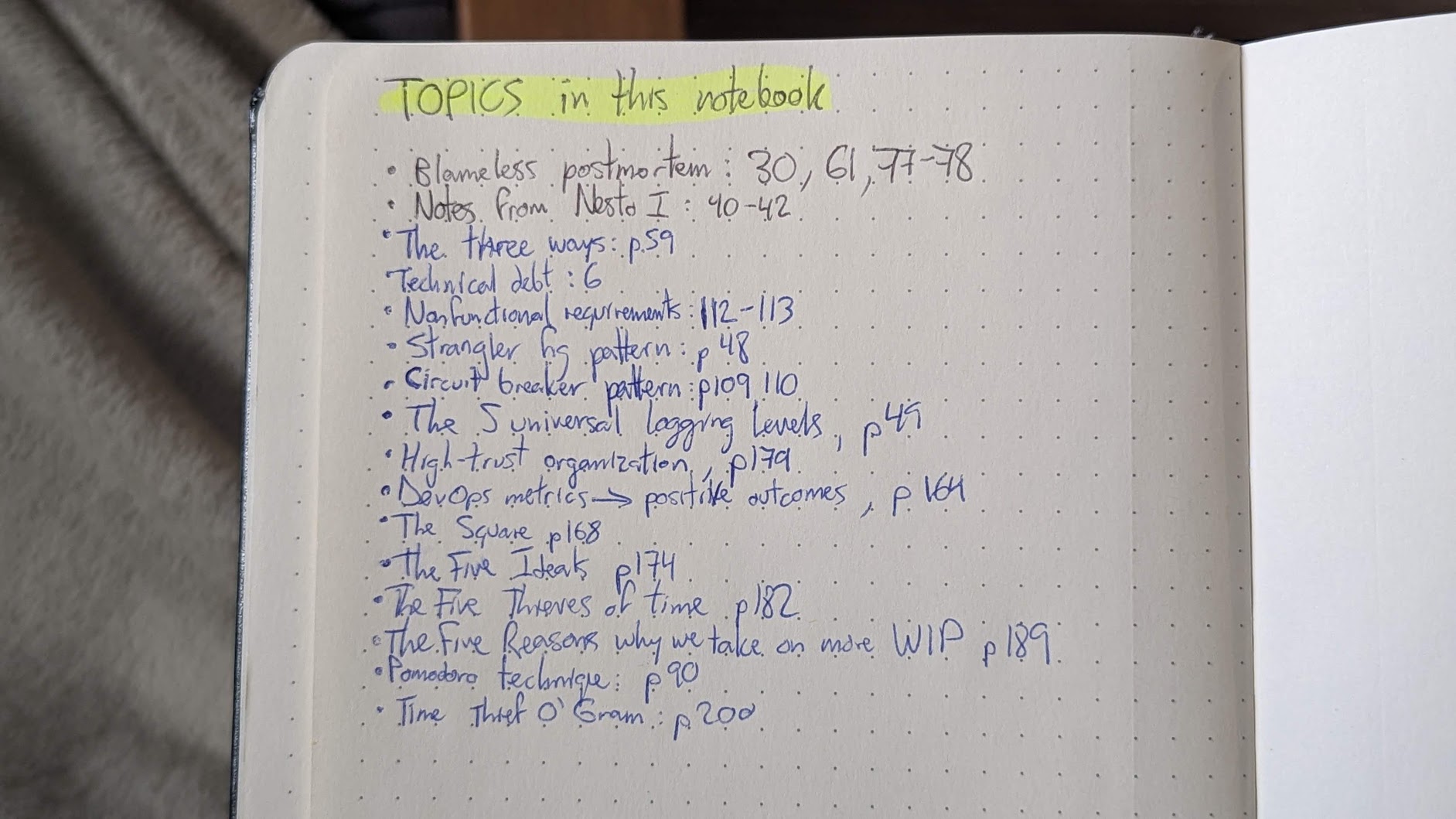
Share the learning material
This is the fun part. When you finished reading a book and collecting all its nuggets in your journal, you are free to share it with the world. In fact, I think it's better to bring the book out of your home and find it a new home where it will be happy. In my case, since my employer provides me a personal wellness account that funds my book purchases, I think it's a no-brainer to bring these books back to the office, where I know they will benefit my colleagues.
Writing the Slack message announcing the newly available book in the library is the victory lap.
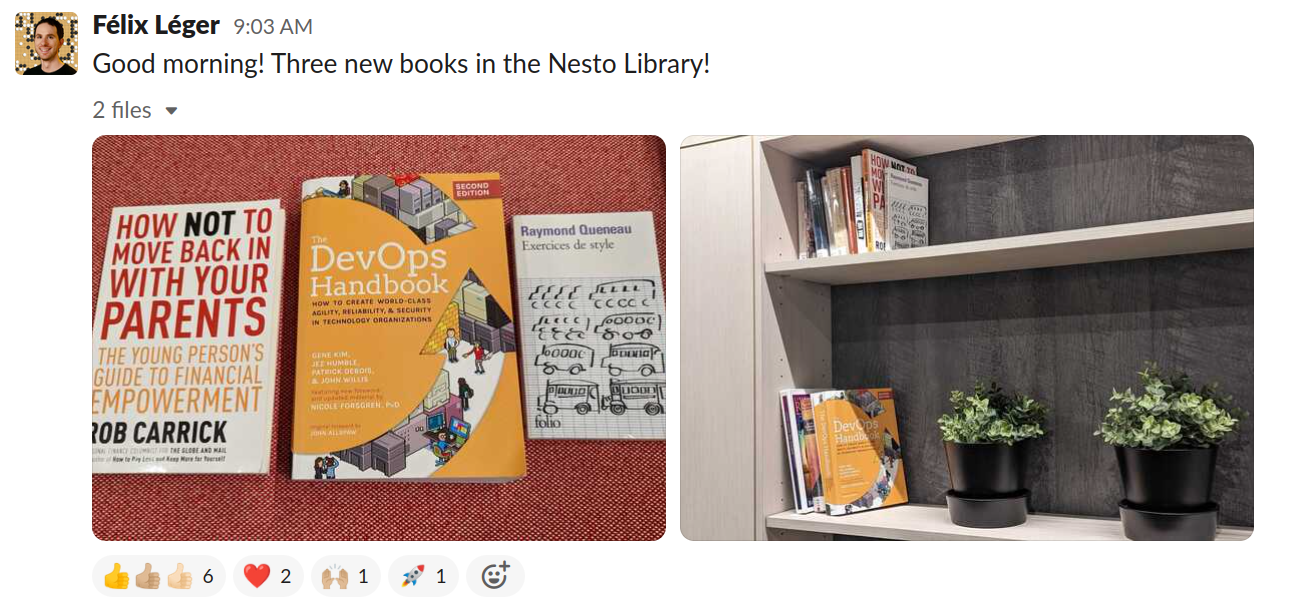
For the DevOps Handbook, since this book meant a lot for me during my personal development, I added a little note on the title page:
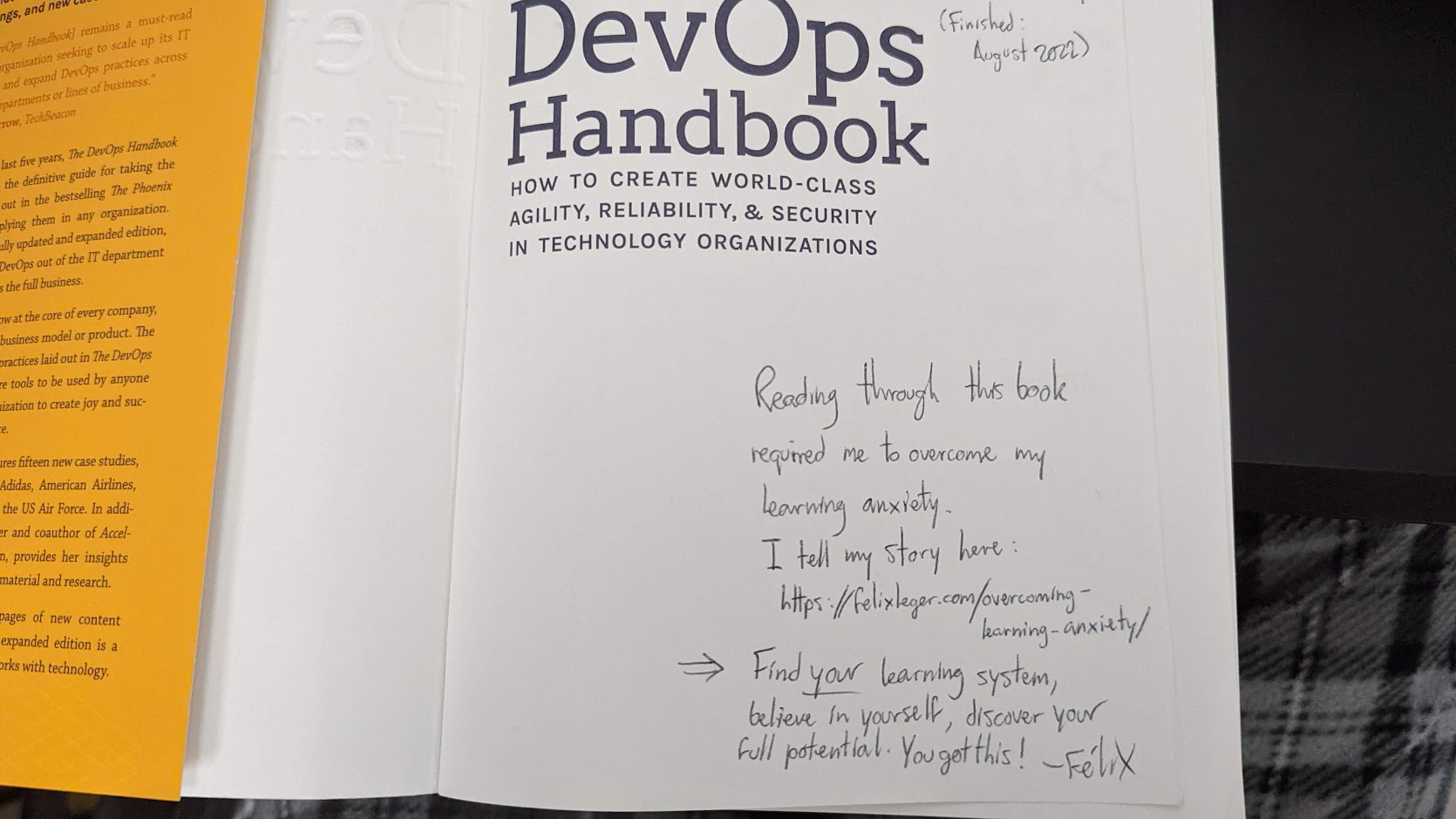
In your next journal, import your best previous nuggets
Always in a effort to make information accessible, what I plan on doing when I fill my current journal and inevitably have to get a new one, is to transfer my favorite nuggets to the new journal. That way, I won't have to constantly switch between journals.
This goes in line with the "single source of truth" principle found in the DevOps mentality. Information is only useful if it is first accessible!
Also, if you have access to a digital scanner, I strongly recommend that you scan the entire content of your finished journal for preservation. You wouldn't want a dumb water leak to ruin all your hard work!
Conclusion
I find this image very telling. My learning system allowed me to compress a 421-page book down to its essential learning nuggets, which take only 50 pages in my A5-sized journal. This means I will get as much information from reading these 50 pages than from reading 421 pages.
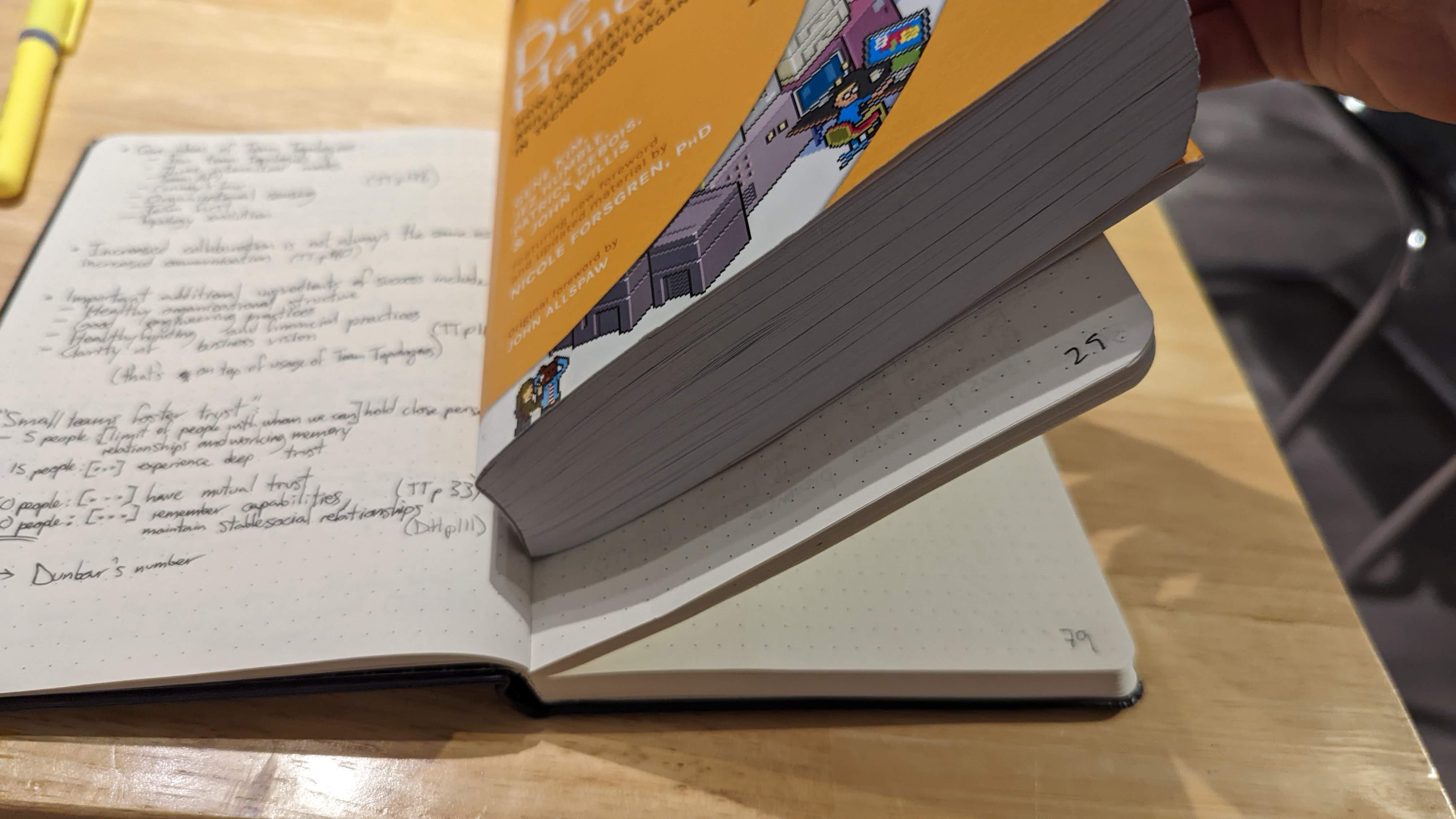
50 pages of pure nuggets!
Instead of taking weeks to review that information, it will take me 1 hour. This feels almost like cheating, except it isn't! I worked hard for this outcome, and now I get to savour it.
Books are not something to be afraid of. Not anymore. I realized I now get to decide which book I read. As a professional, I am the master of my own learning. As the DevOps Handbook rightfully puts it on page 320 of its second edition:
The only sustainable competitive advantage is [your] ability to learn faster than the competition.
Textbooks have a purpose outside the classroom, even if that means you won't have a professor dragging you through it. Not all textbooks feature exercises and homework; some can be quite fun, relaxing, enlightening to read, without creating headaches or feeling like puzzles. A book you chose almost certainly contains parts of the answer to the question that made you choose it.
Imagine how you will feel when your book shows you a new way to think about a specific problem you couldn't quite put your finger on. Suddenly, a new connection occurs in your brain. Now, all you can see is the answer. Everything simply makes sense! Personally, this is among the most powerful and freeing experiences I have felt yet. It truly is a transcending moment that cannot overstated.
Learning does not have to be a skill. We are all lifelong learners. What allows some people to learn faster than others is that they have created and optimized a learning system that is suited around their way of learning. When I realized that the core mission of DevOps is to create a system that automates organizational learning, I felt the pinch of irony, because to realize this, I had to create my own system of learning. Now that this is done, I feel more empowered than ever and ready to take this challenge head-on.
As a child who wanted to become a teacher for most of his life, I can't be more satisfied with my current career choice: teaching businesses how to learn. I have no idea what I did to land on this path, even though it was far from a painless experience to get here. I finally feel like I'm on my X.
If you personally suffer with learning anxiety and made it this far in this blog post, I'm confident that you are already on the right path. I hope the ideas I have outlined will inspire you to find your own system and rediscover the simple, sacred joy of learning. There are still challenges ahead, and there always will be. For example, I am still having issues learning through reading webpages, even accounting for distractions. That suggests there is another system that I will inevitably have to adopt eventually1. I've done it once, so I trust I can do it again and, hopefully, in less time than it initially took me (3 years)!
After all, that's what learning is all about! 😉
This blog post was initially featured on my personal blog, felixleger.com
2022/08/22 Update: I believe I have found a tool that can help learning from browser pages! Highlight by Weave-Trix for Firefox. ↩︎
